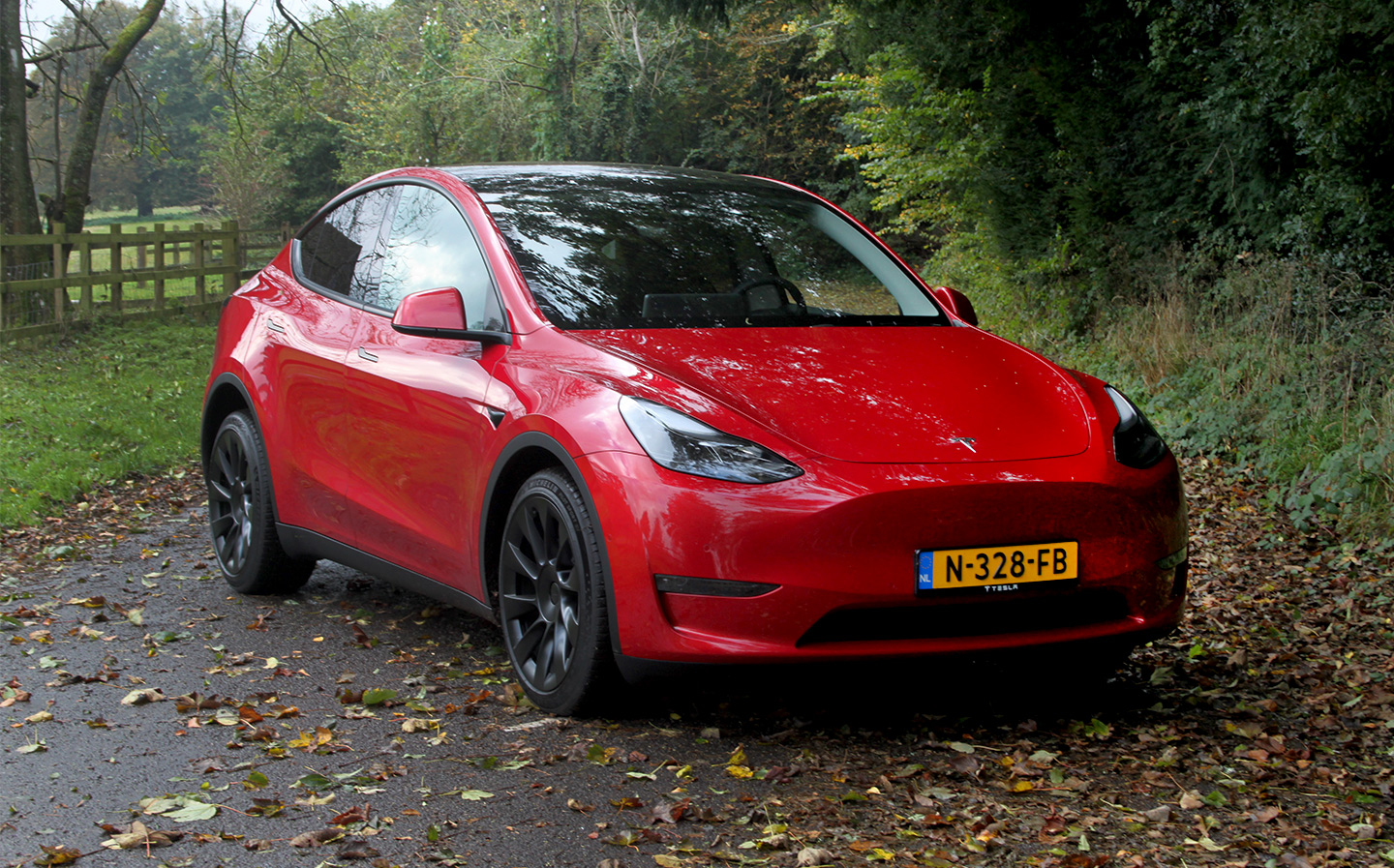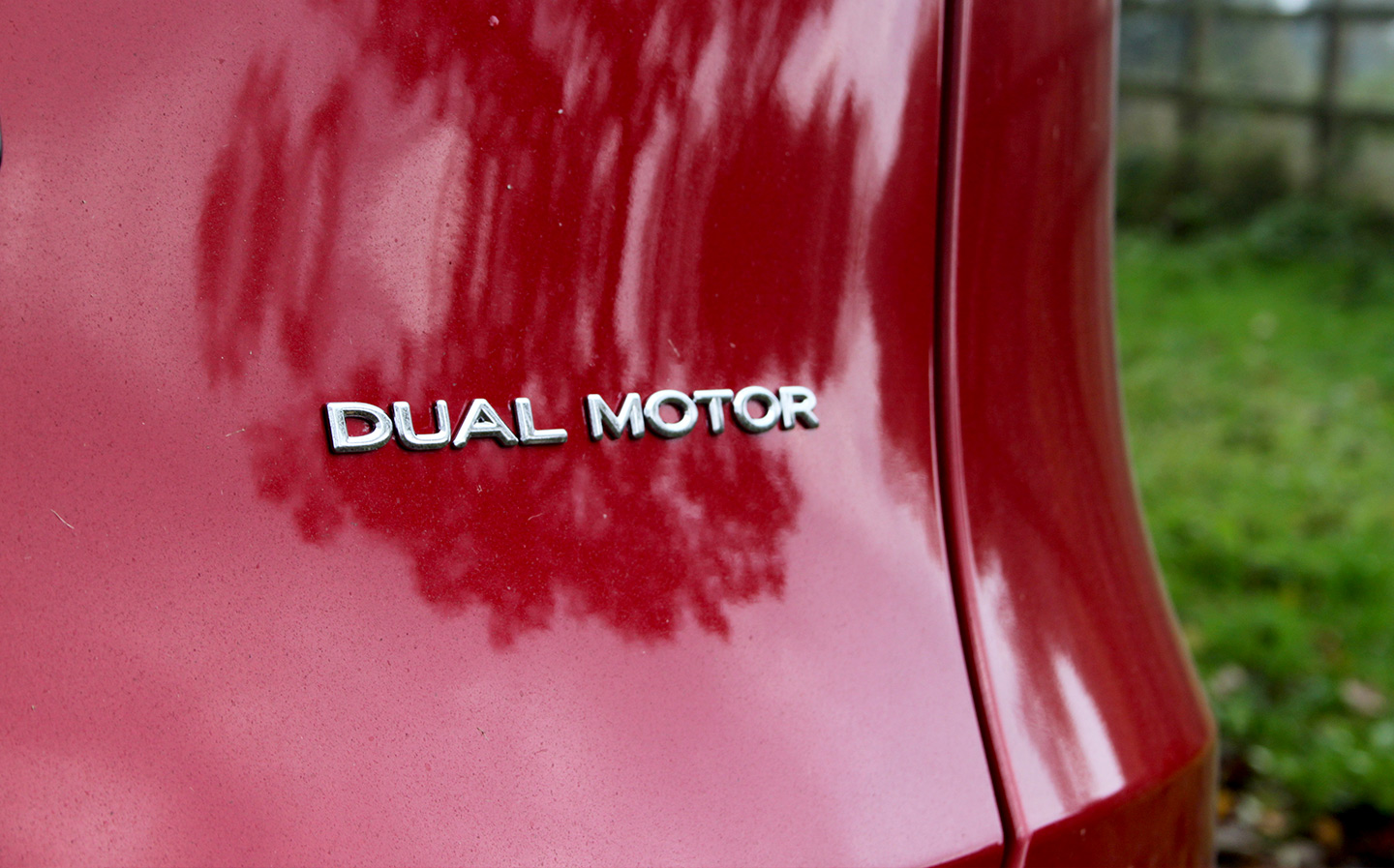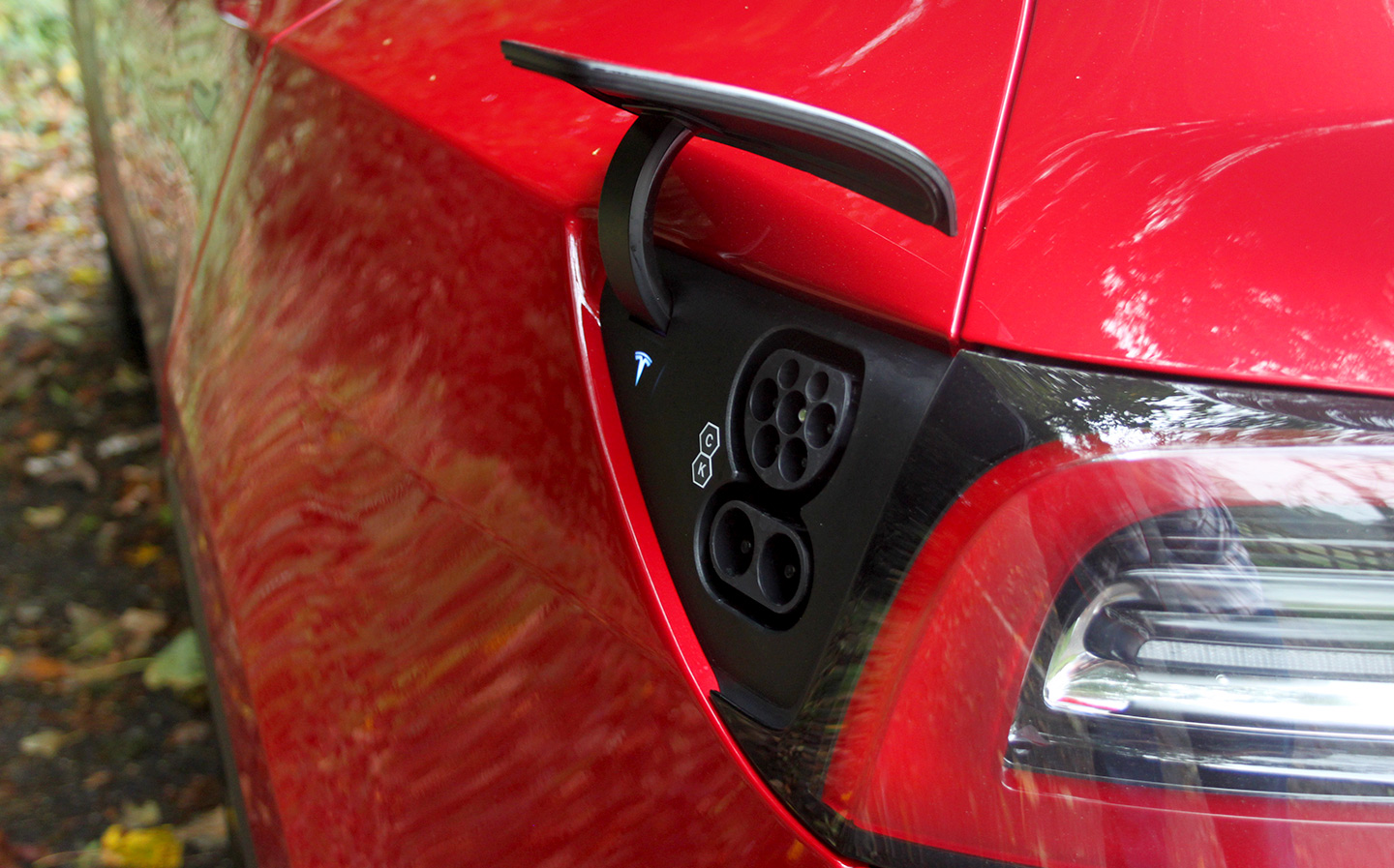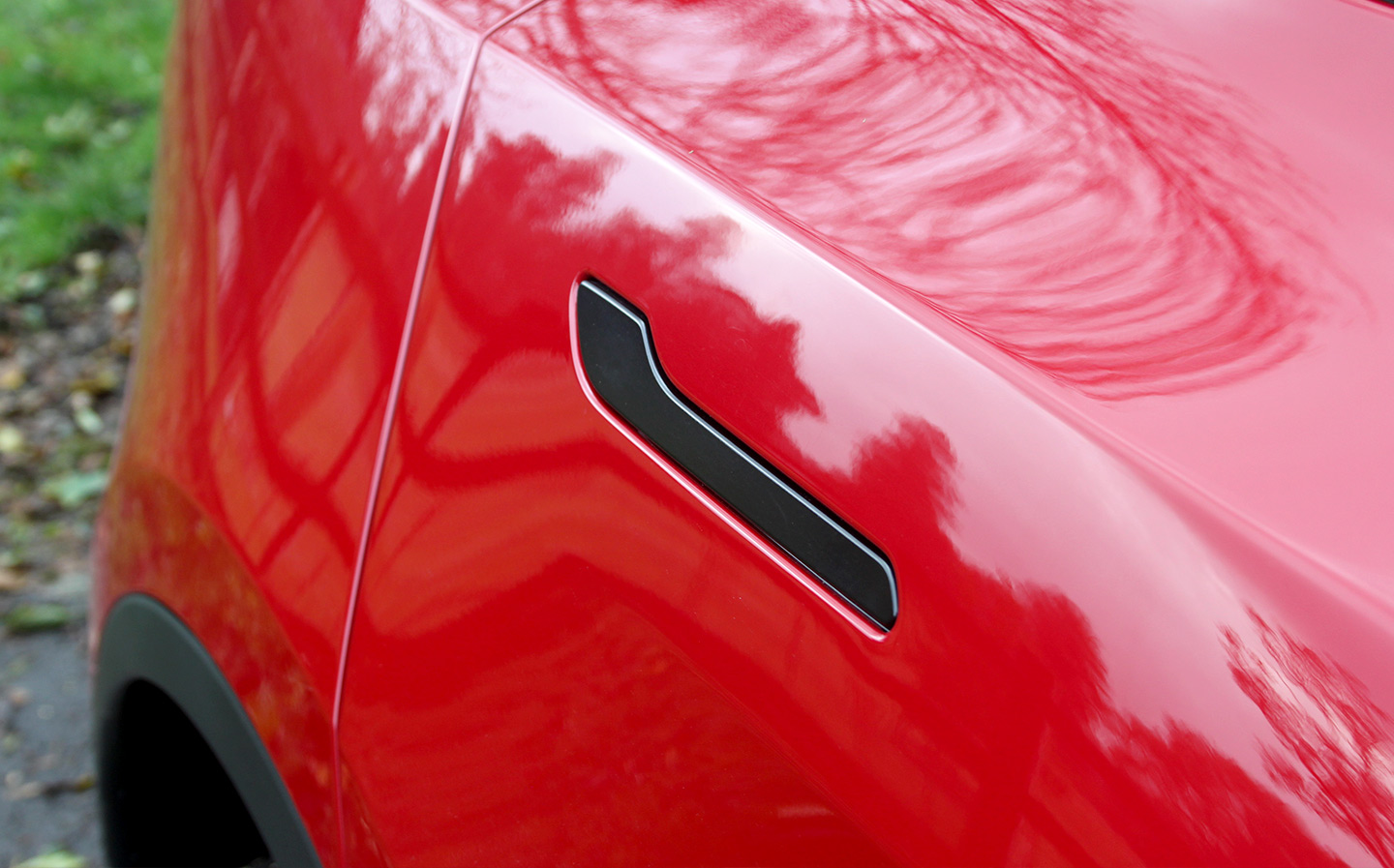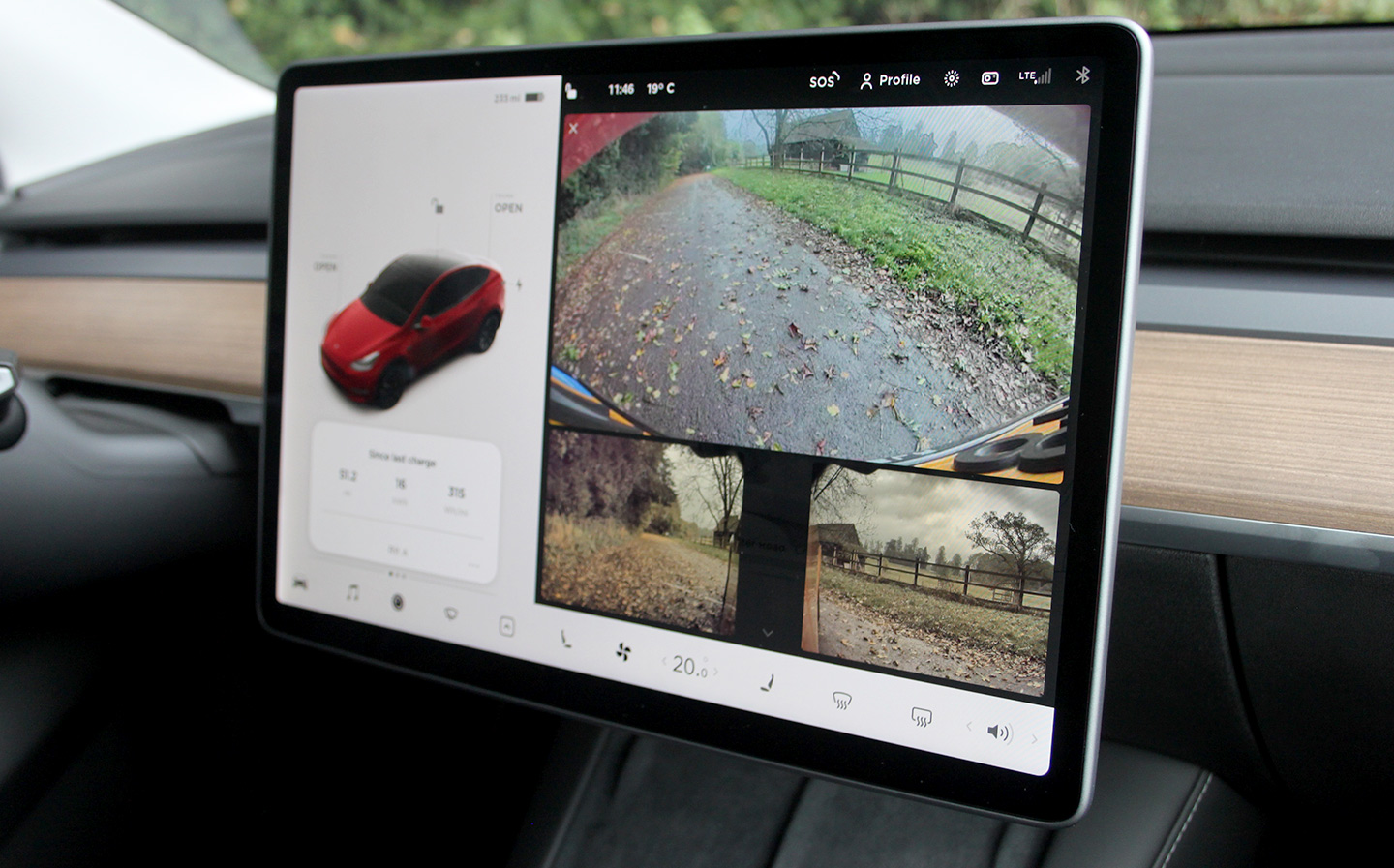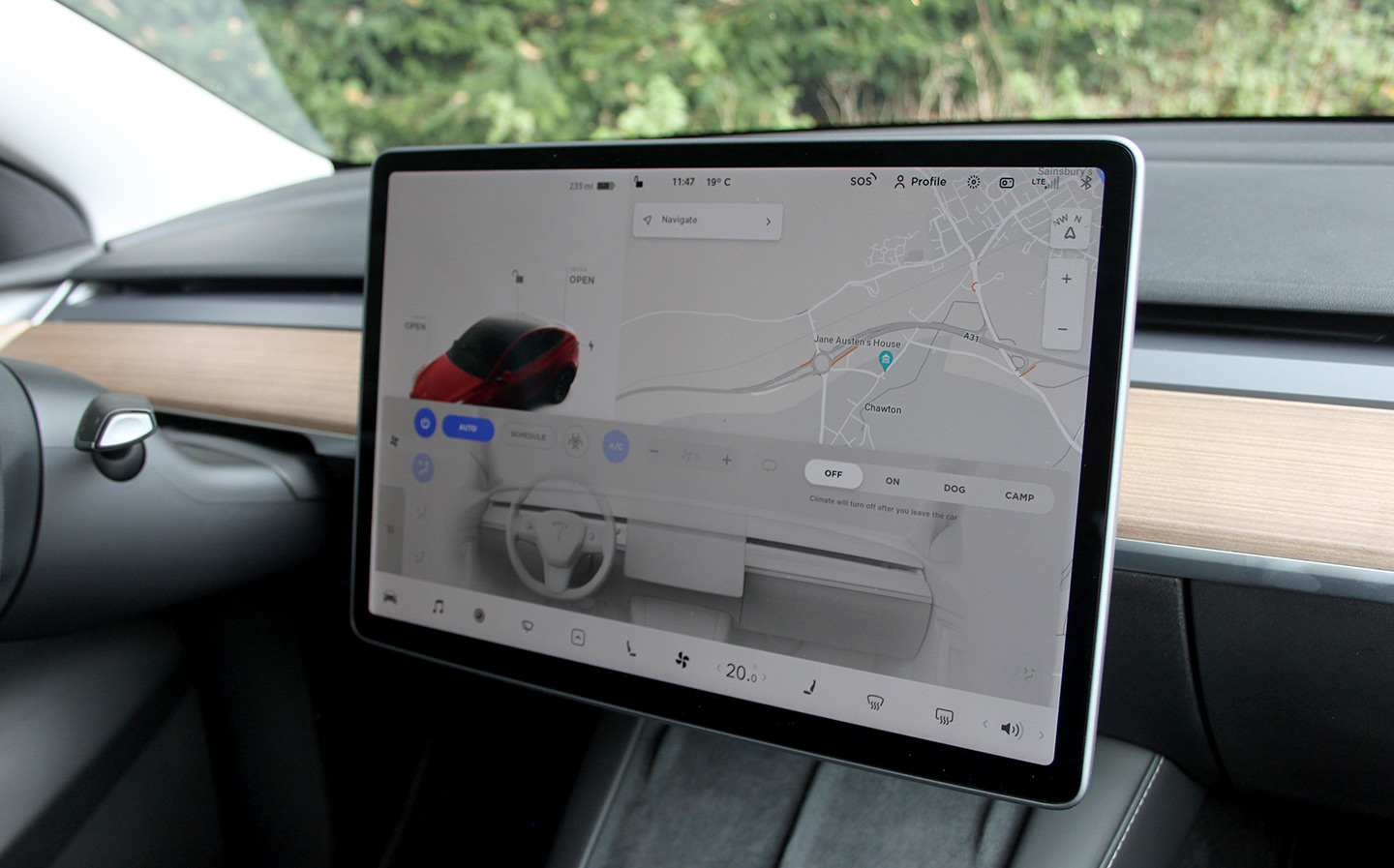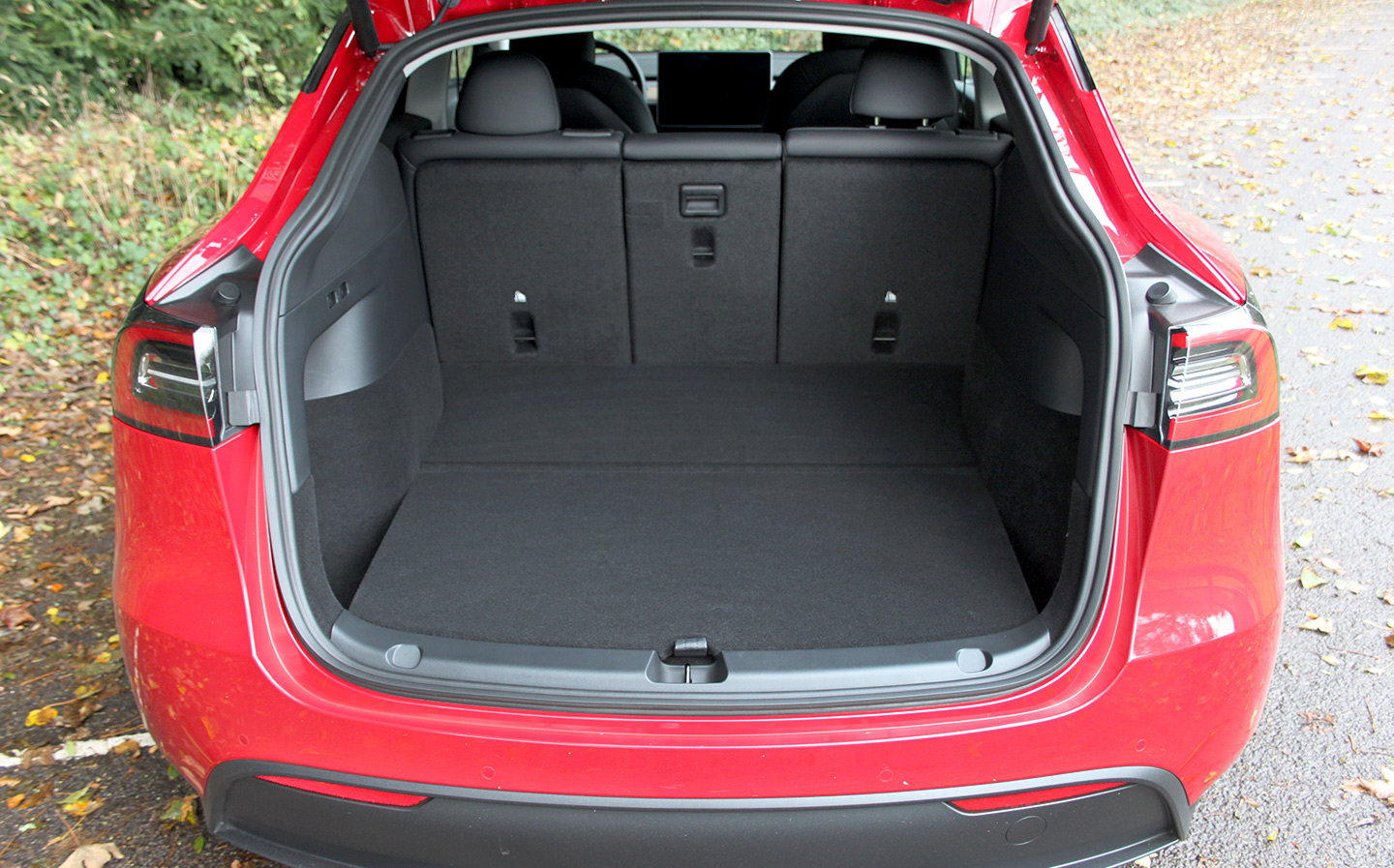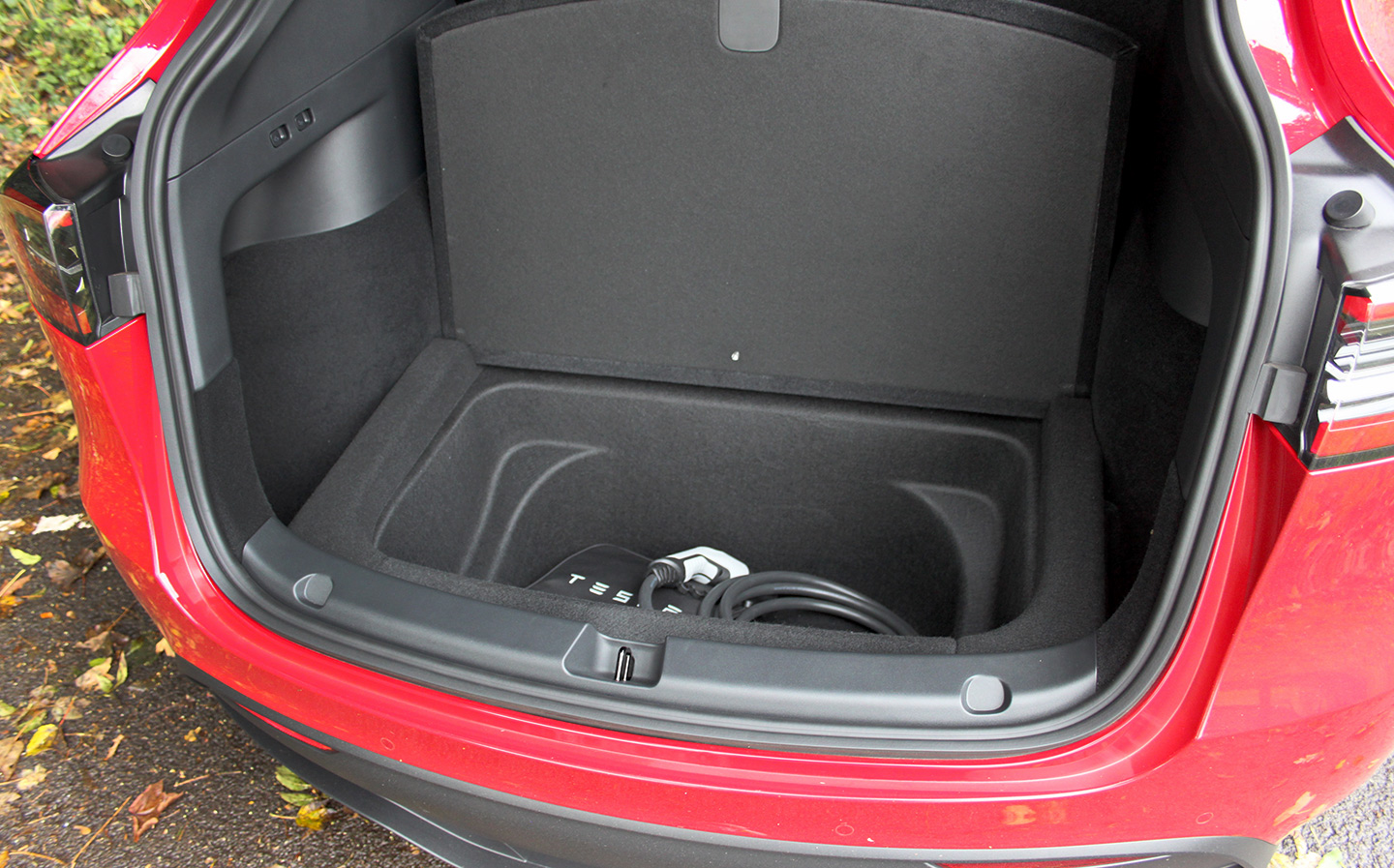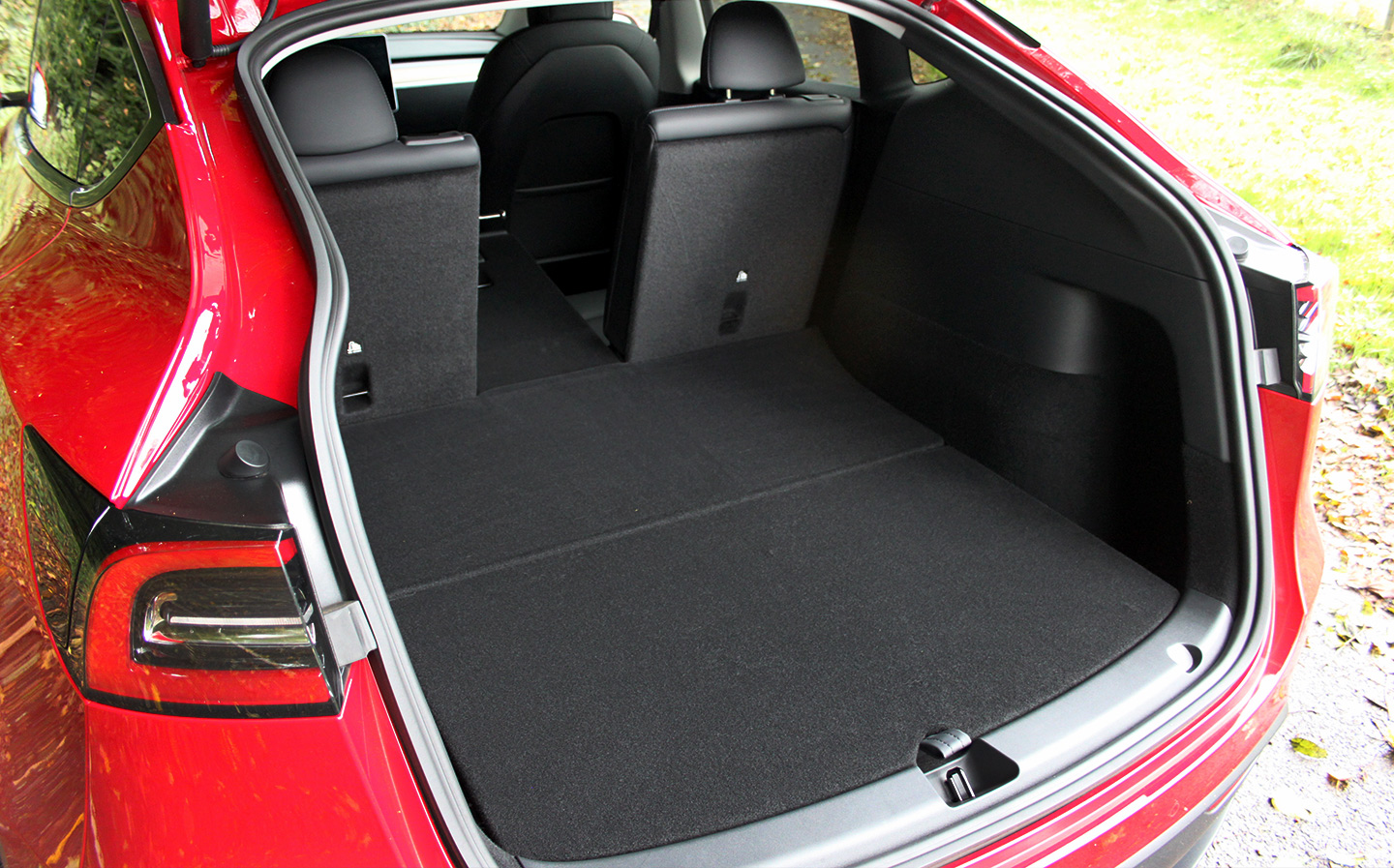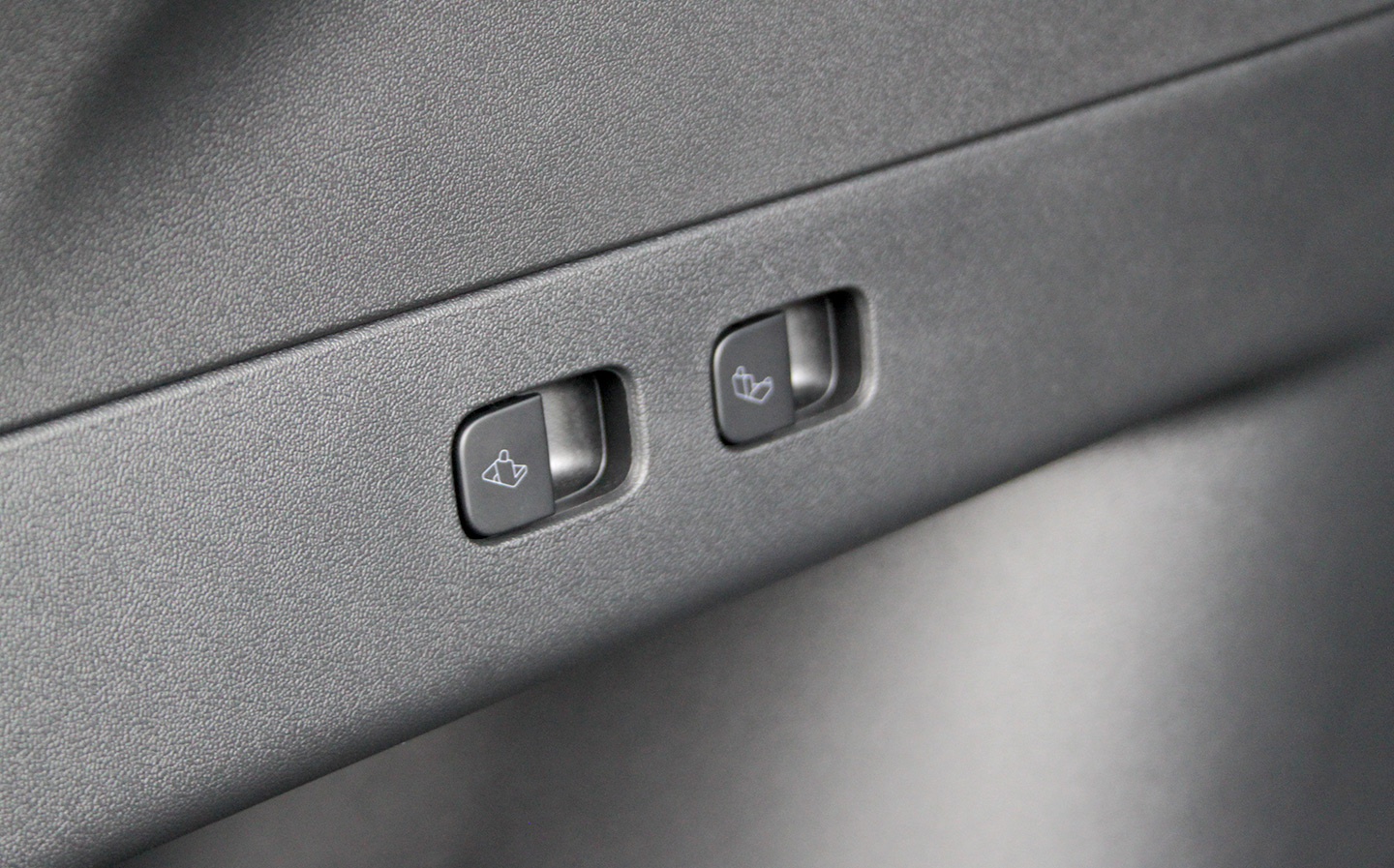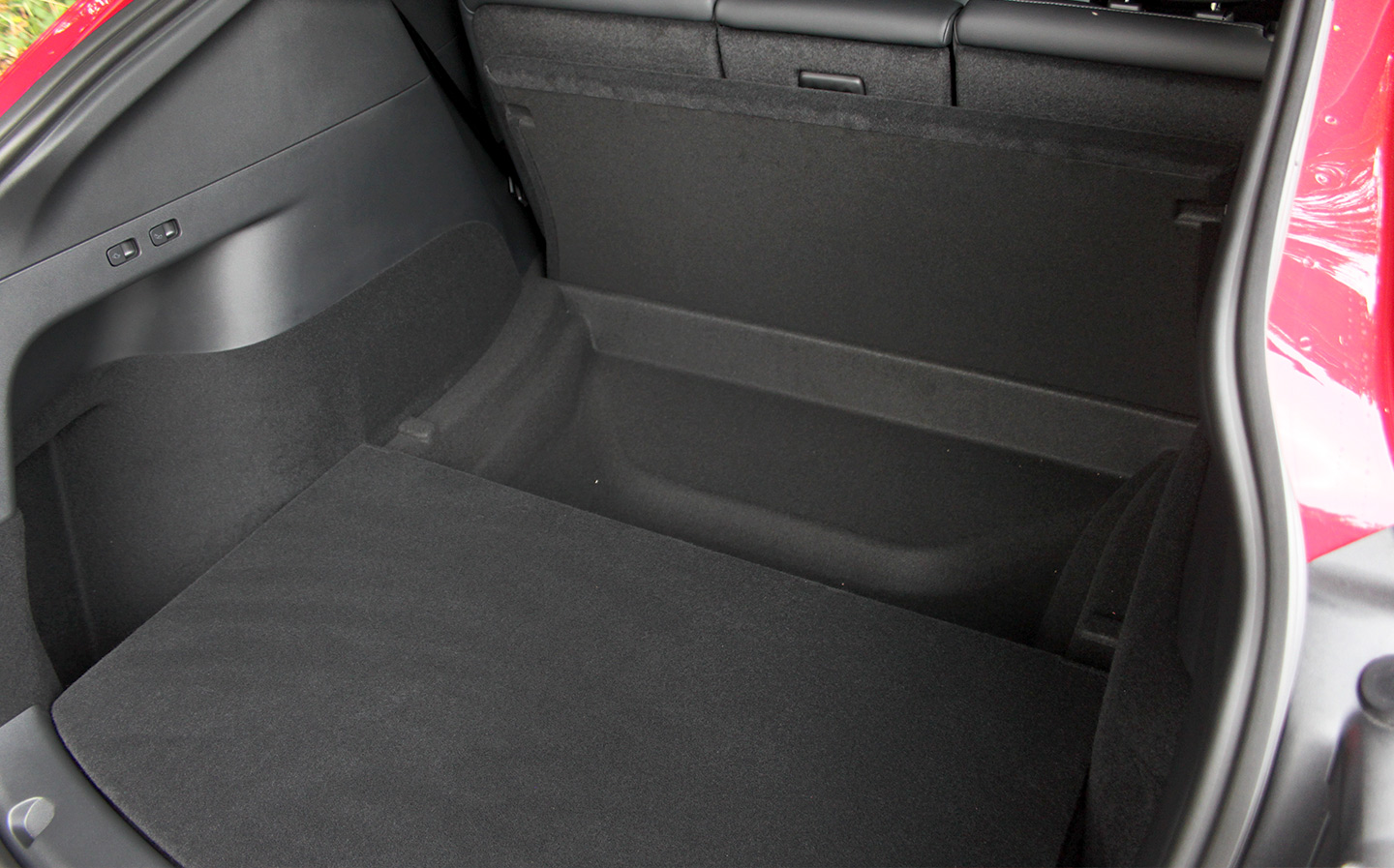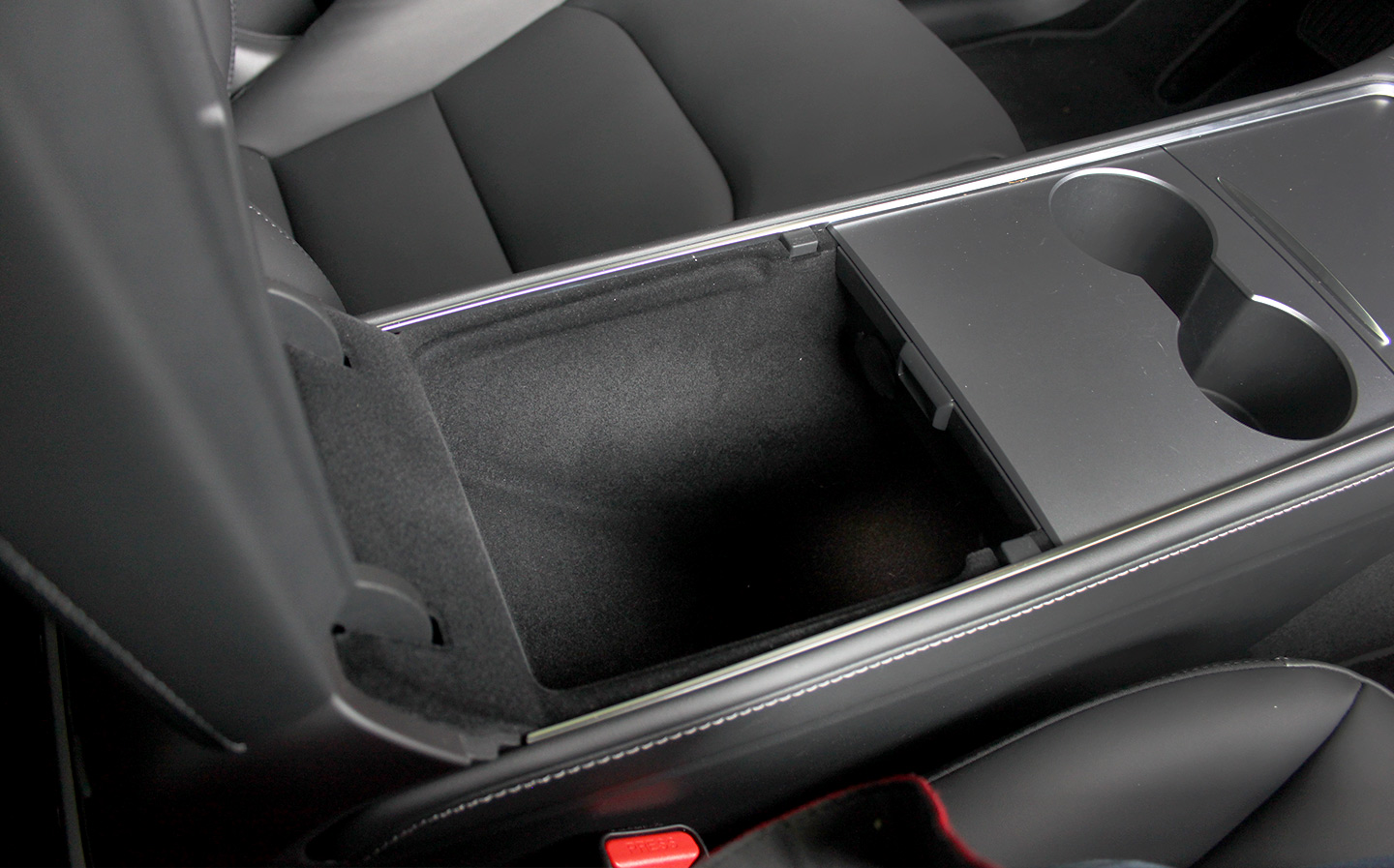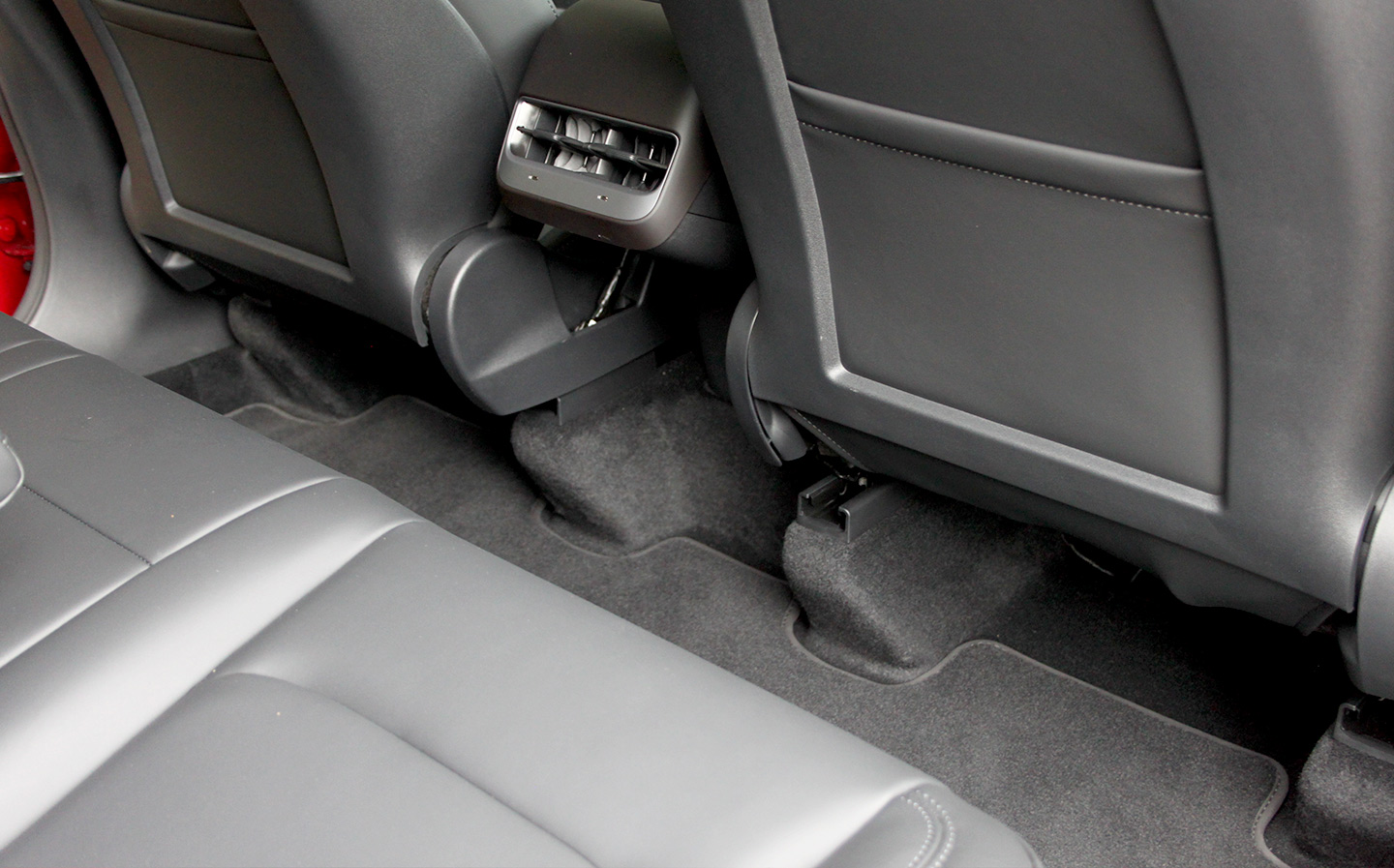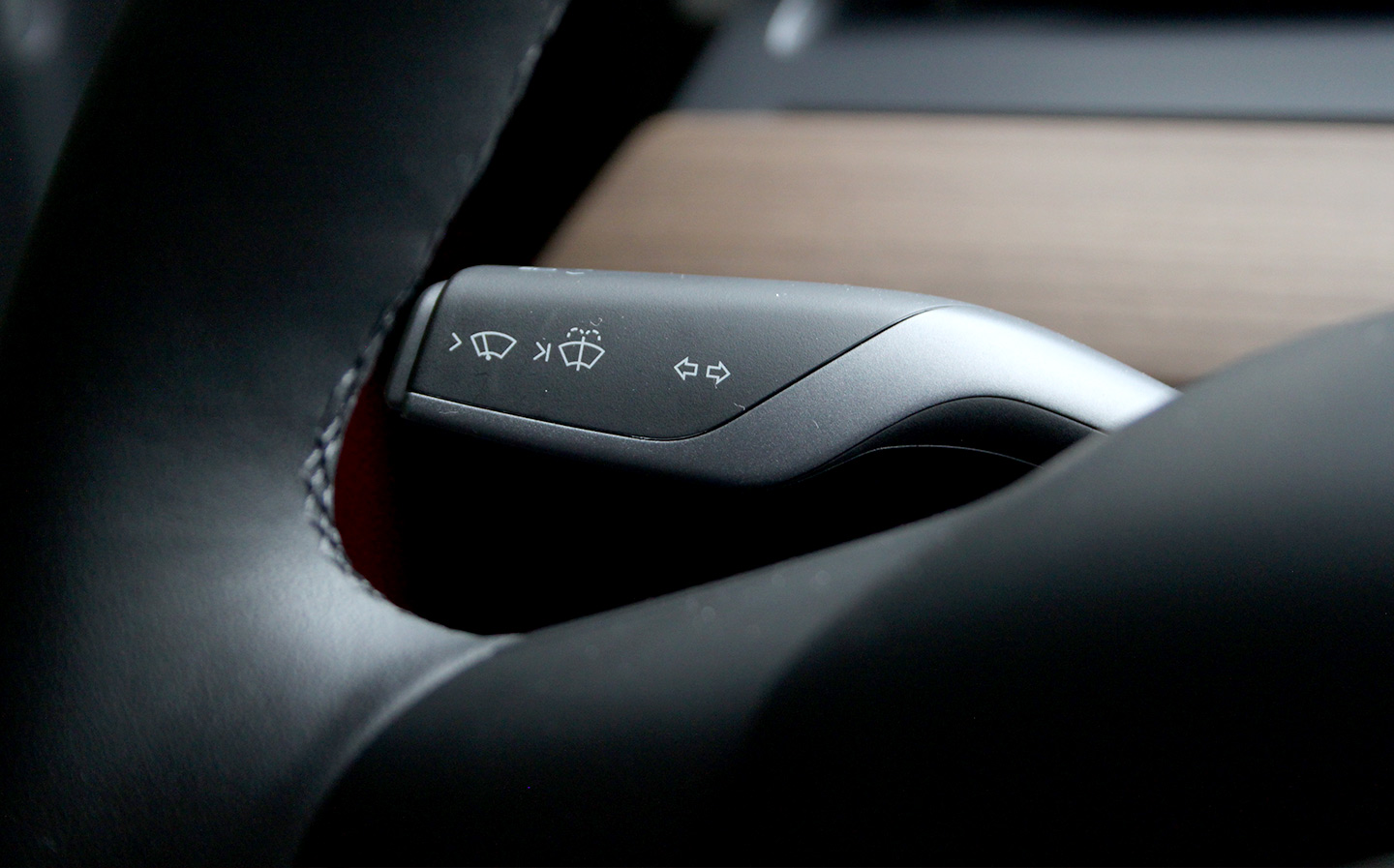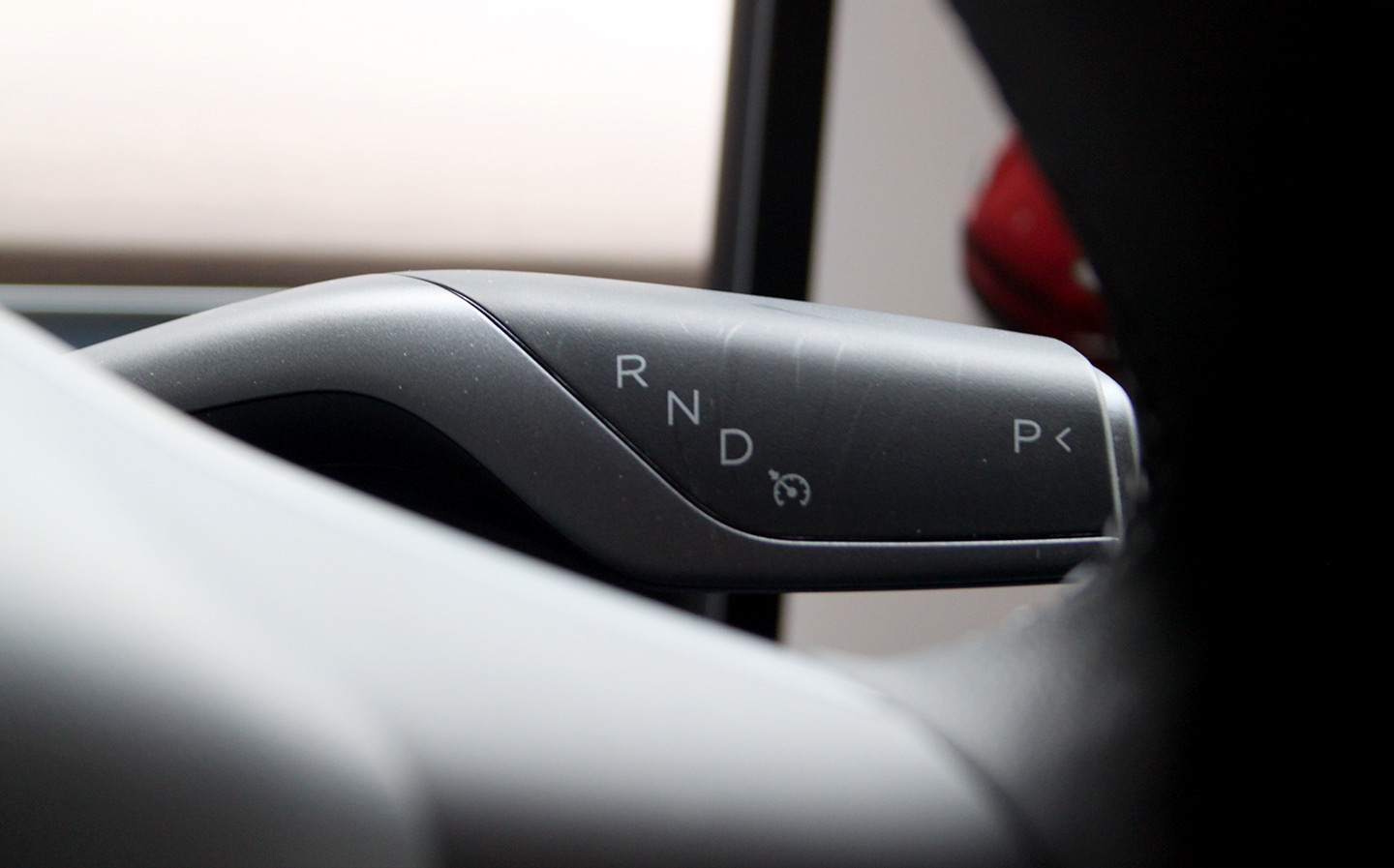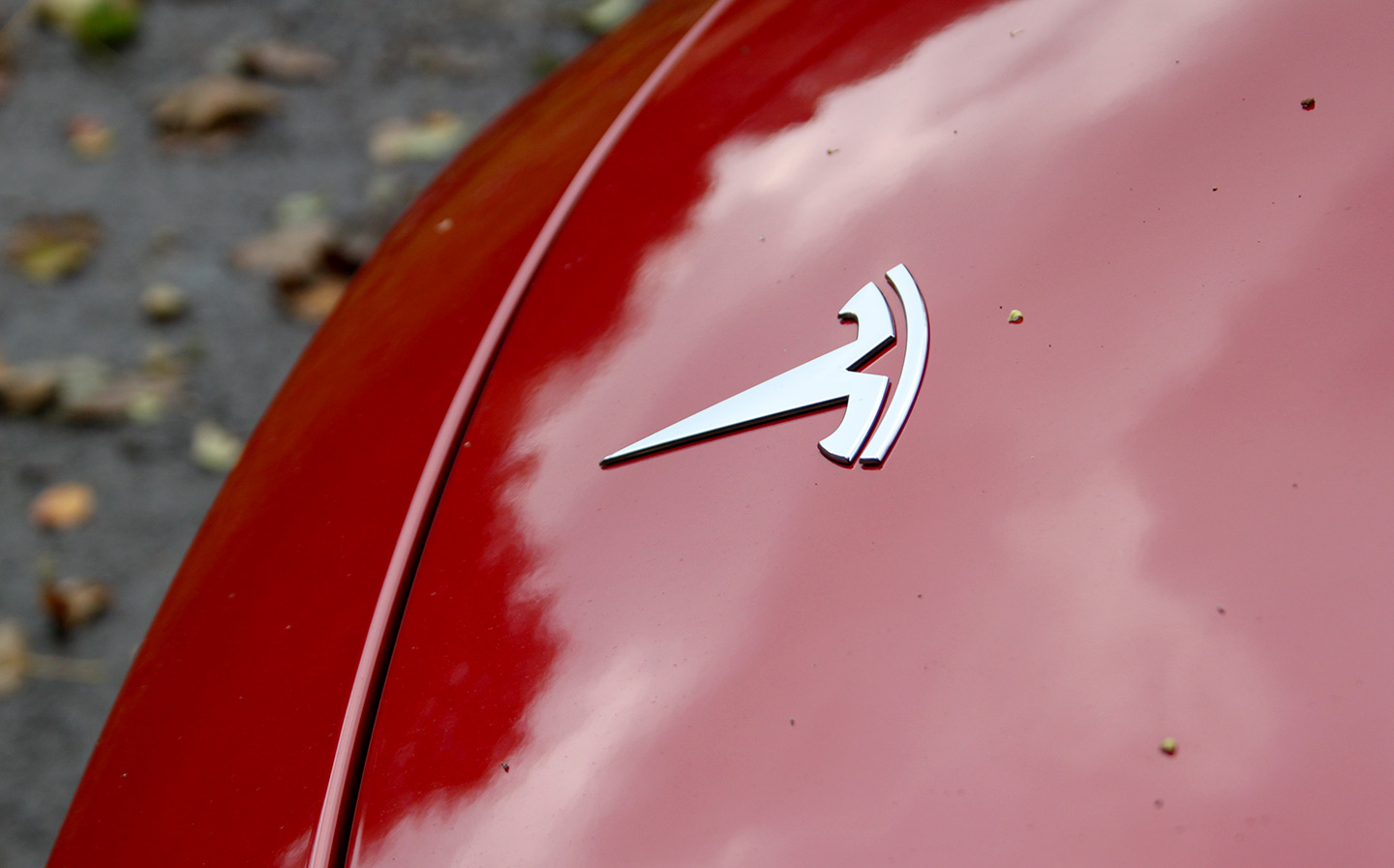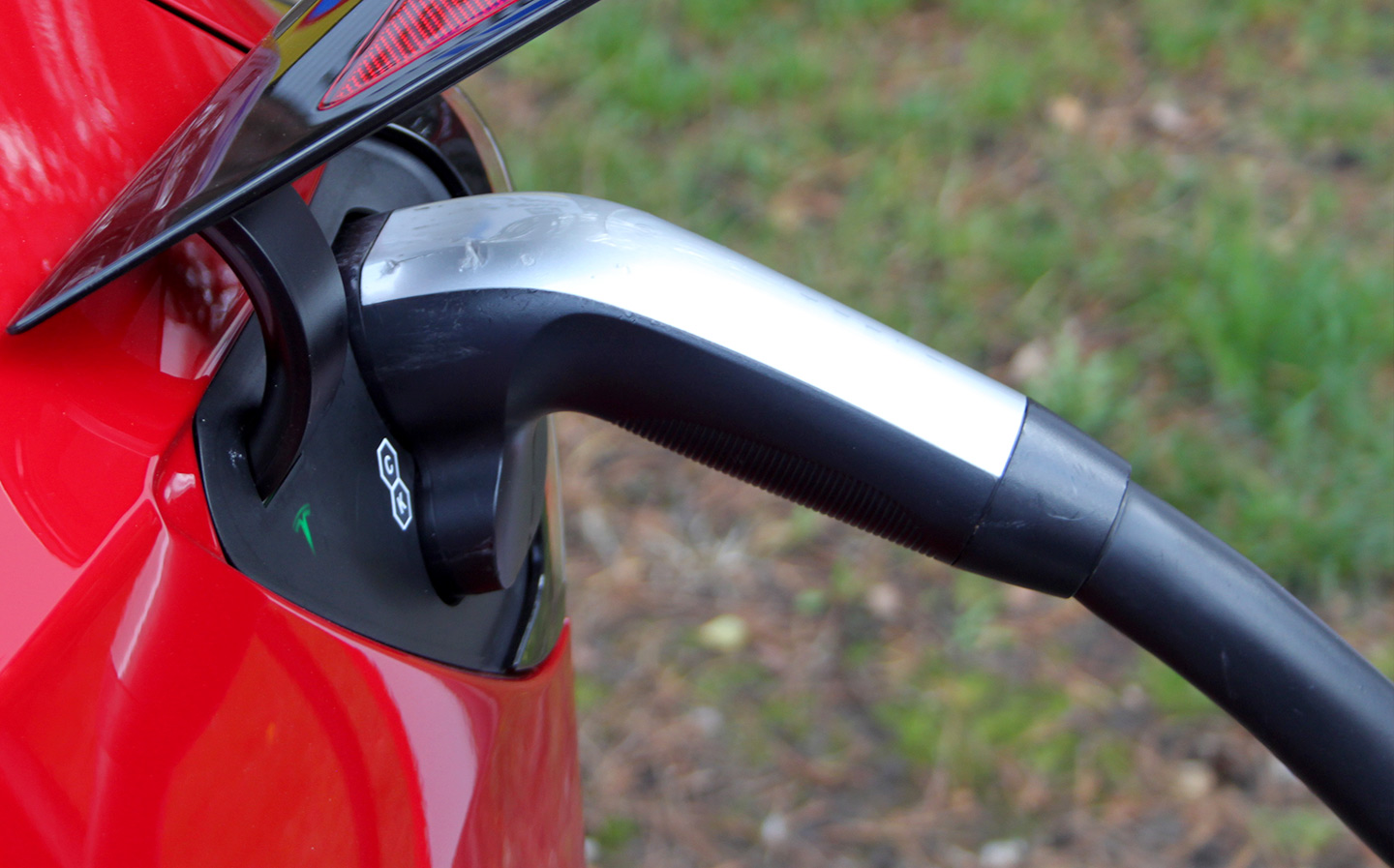Tesla Model Y 2022 review: Far from flawless crossover... but we forgive it
Electric crossover completes Elon Musk's S3XY quadrilogy
THE TESLA Model Y is an important car for the American electric vehicle company. Elon Musk, Tesla’s eccentric CEO, always planned to create high cost, low volume cars before getting to the more affordable mass-market models. The pricey Roadster, Model S and Model X allowed Tesla to build profit, reputation and an industry-leading recharging network, before the Model 3 compact saloon was launched for less well-heeled drivers (at £40,000, “affordable” is relative).
And while that compact saloon is selling like hot cakes — it was the UK’s most popular car in September, officially (though partly because a boatload of cars arrived at a UK port and were all registered at once) — the Model Y could be an even bigger success because, well, it’s a compact crossover; a type of car buyers just can’t get enough of these days.
The Model Y is “95% Model 3”, we were told before our test drive, but has a higher stance, more room for rear passengers and extra luggage space.
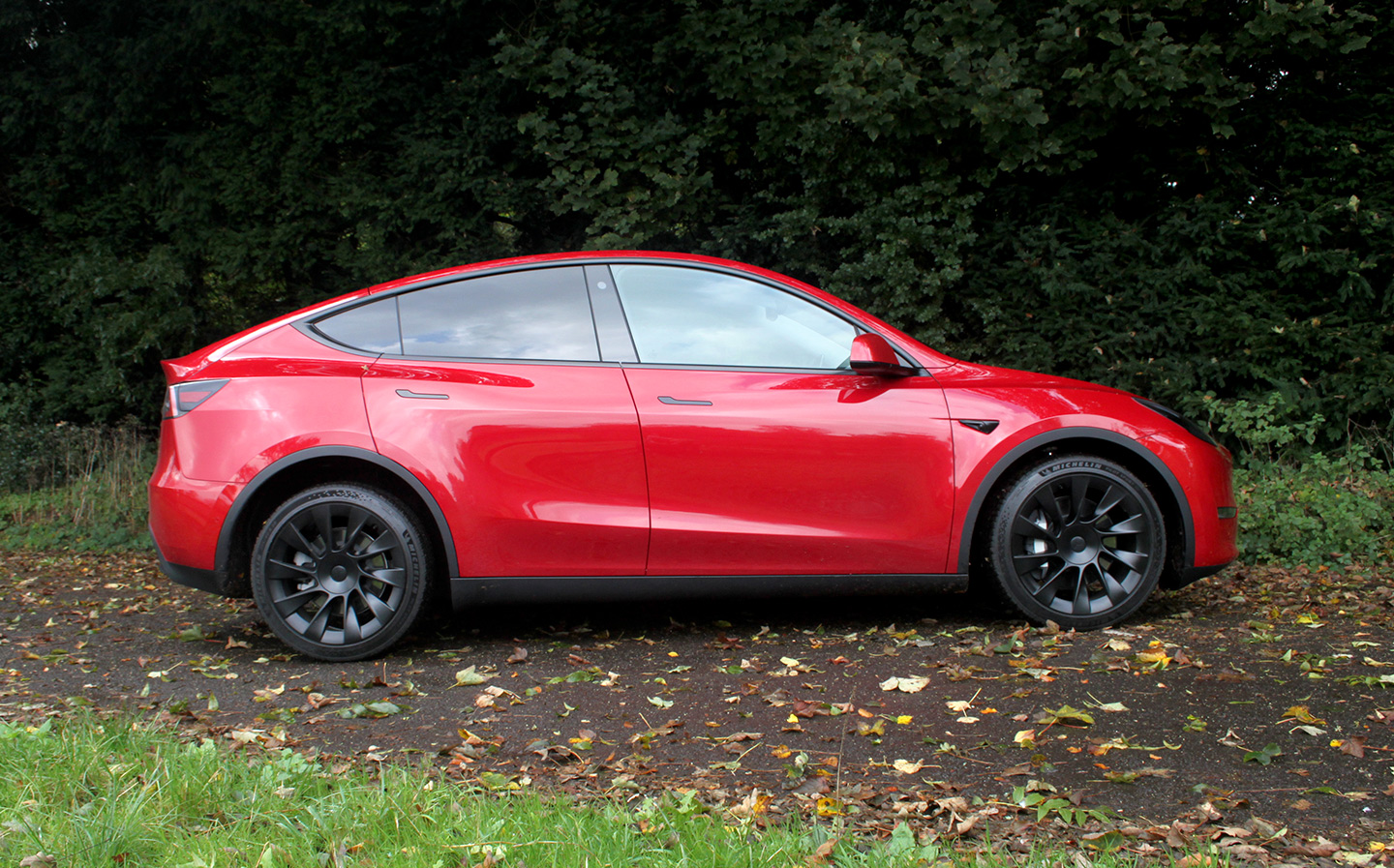
Though Americans can order seven-seat versions, in the UK it’s strictly a five-seater, and comes in two flavours: Long Range AWD and Performance. Both have two electric motors, which drive all four wheels, but as the name suggests the Performance version will pack more of a punch in terms of acceleration.
The first right-hand drive versions to be shipped from Tesla’s Shanghai factory will be the Model Y Long Range AWD, though, so if you can’t bear to see other people driving around in them before you and want a delivery in early 2022, you’ll want to pick the less-sporty one. Otherwise, the Performance versions are expected to arrive from the summer.
Exterior design and rivals
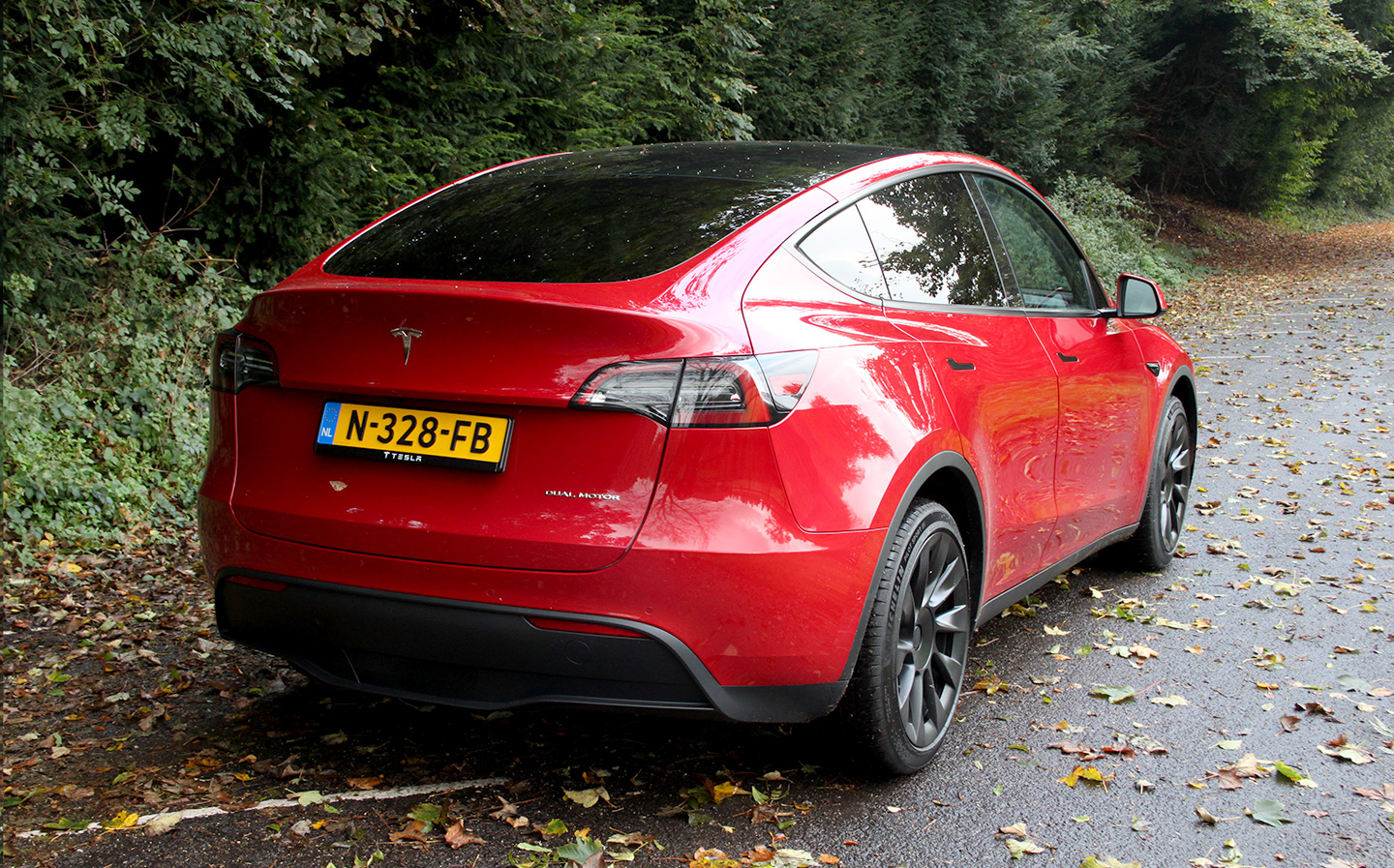
The forthcoming (at some point, maybe) revised Roadster is a sexy machine but the only properly good-looking Tesla currently on our roads (though no longer for sale new) is the Model S. Sorry, Model X and Model 3 owners, your cars are not hugely attractive. Slippery through the air, yes, but they’re unlikely to win first prize in a beauty contest.
Somehow, though, as a shrunken Model X with a Model 3 nose, the Model Y is more attractive than both. And fortunately some of its rivals, including the Skoda Enyaq iV, Volkswagen ID.4 and Kia EV6, aren’t the prettiest models in the car park. Purely on aesthetic qualities, the Volvo XC40 Recharge, Hyundai Ioniq 5 and Ford Mustang Mach-E (winner of our Car of the Year 2021) rule the roost in this market.
Riding on the upgraded 20in wheels (they’re 19in as standard), especially painted black, as on our test car, and with tinted rear windows, the Model Y does have a purposeful look. The Performance model will likely be even more aggressive, of course, partly because it comes with even larger 21in rims. Bigger always mean better when it comes to alloys, though, and that’s certainly the case with the Model Y. We’ll come to that in a bit.
But looks aside, what you get from Tesla is class-leading aerodynamics: there’s no grille, the door handles are flush to the body and the shape of the rear end results in low drag through the air, which, combined with clever motor and battery control systems, helps their cars go farther than most rivals per charge. What really marks out the Model Y over the Model 3, though, is even more exceptional packaging.
Interior, technology and practicality
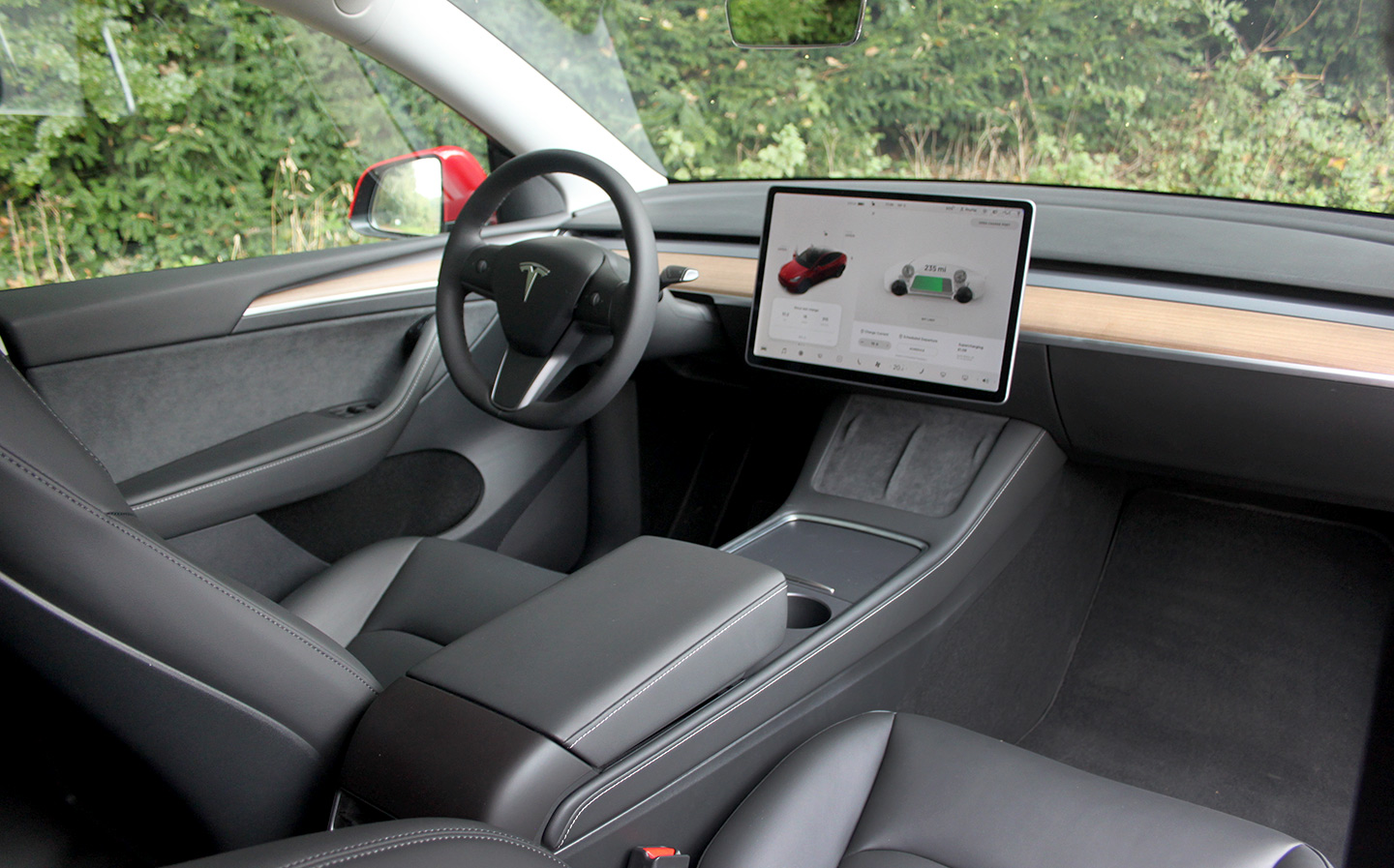
Tesla has outdone itself with the interior of the Model Y. The minimalist design from the Model 3 continues largely unchanged, with clean lines, lots of space and an airy feel in the cabin.
The dashboard of course is dominated by the huge touchscreen, from which most of the the car’s functions are controlled. It responds quickly to the touch and on the whole is well laid-out.
On the left hand side you’ve got driving information such as the road’s speed limit, your current speed, and both battery range and level. It’s not entirely obvious at first but swiping right reveals the trip computer, with information including the odometer and energy use since the last recharge.
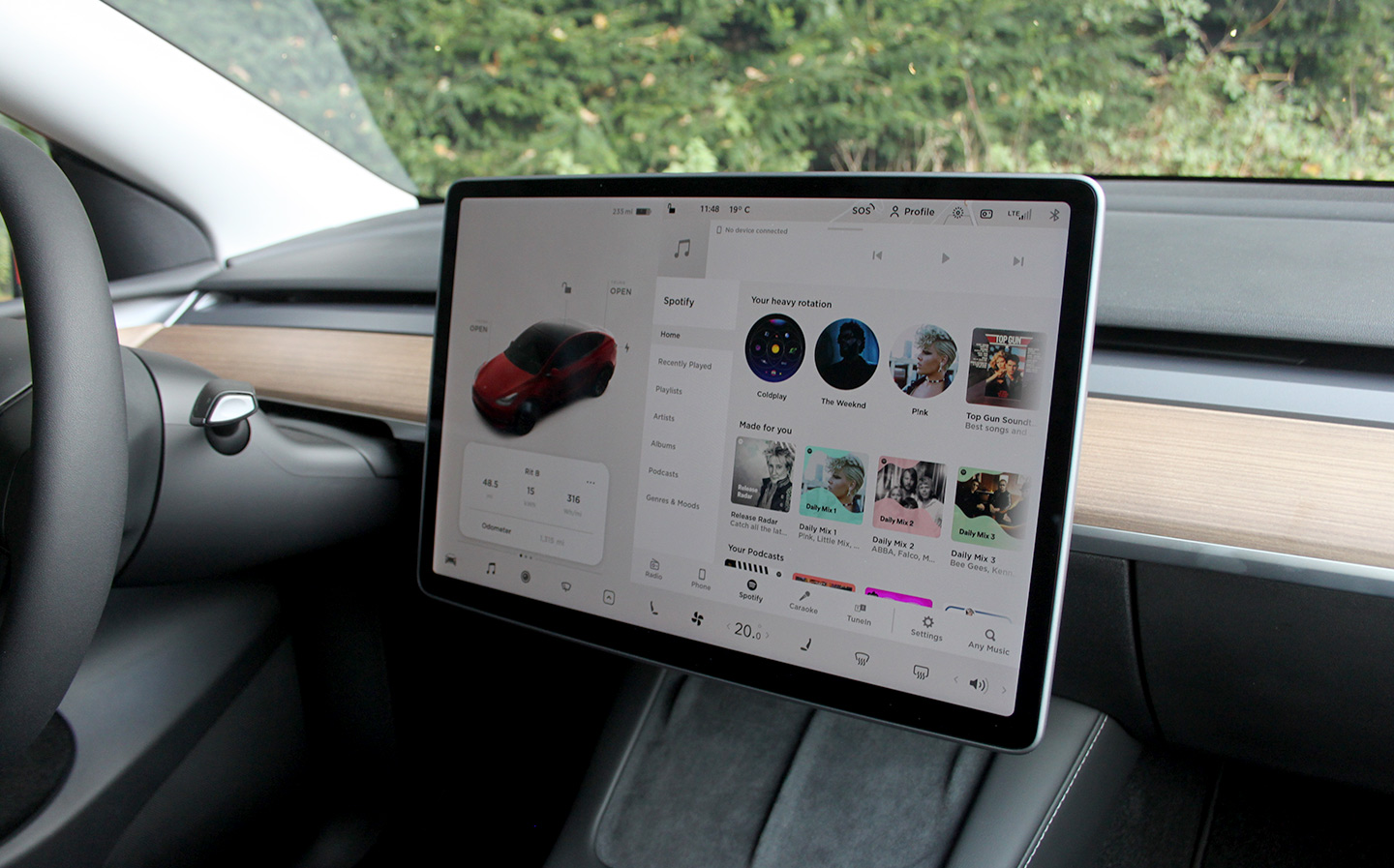
On the right hand side there’s a large sat nav map, which is clear and nicely integrated with the car, as well other connected infotainment such as internet radio, podcasts, web browsing and Spotify. And as with other Teslas, when you stop to recharge there are even a few video games that you can play.
That’s one of the things that Tesla has really nailed: not only its recharging network, which is expansive, well-located along arterial roads and capable of ultra-rapid top-ups (see below), but also keeping customers entertained while they are waiting for the car to recharge. It’s very, very smart stuff.
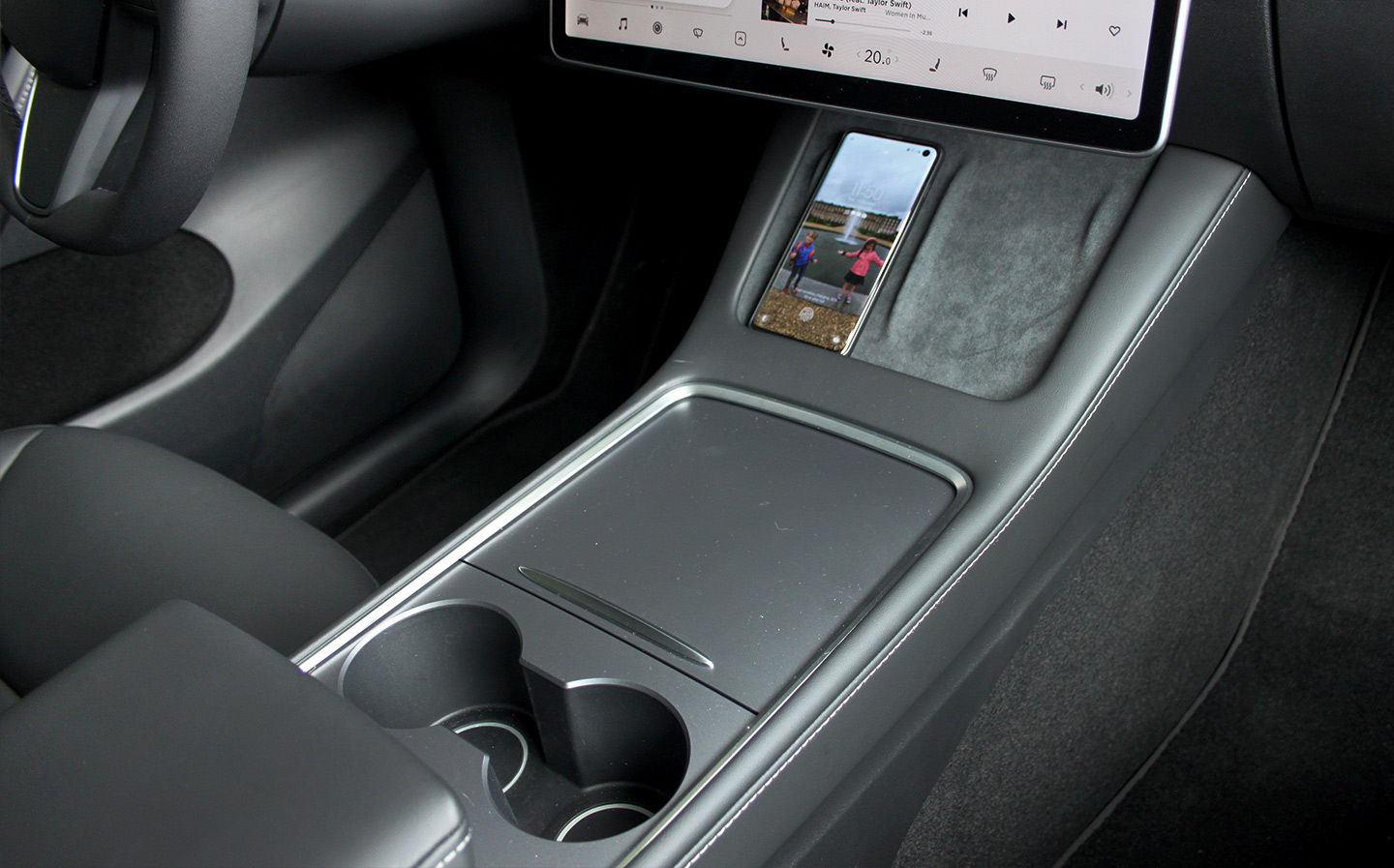
It’s not perfect — it isn’t terrifically easy to find radio stations, for example – well not quite obvious enough for a person first getting into the car, at least. To find Times Radio, I ended up using the search function and then scrolling past various music and podcast recommendations before coming to the station itself. But the beauty of a fully-digital infotainment system with “over-the-air” updates is that it can be improved over time.
And the quality of the sound from the 14-speaker stereo is absolutely superb — it’s a very high quality system, helped in part because the car is electric, so Adele’s vocals aren’t competing with the thrum of a petrol engine.
As with the dashboard, the steering wheel itself is a minimalist affair, with the left scroll wheel allowing you to adjust the stereo volume and, via a menu on the touchscreen, the door mirrors, and height and reach of the wheel.
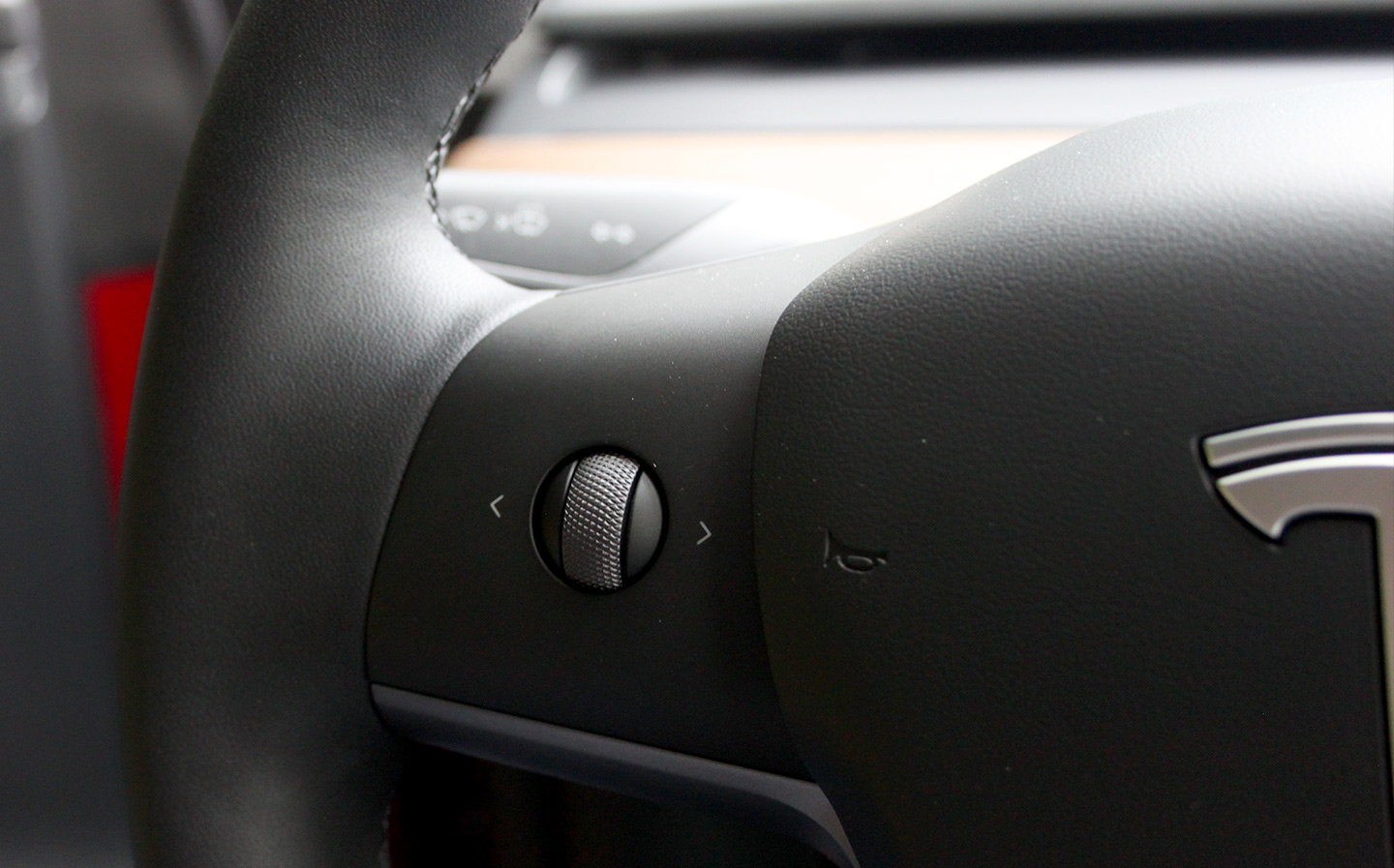
The right-hand dial is for the cruise control speed setting, with the system activated via a double tap down of the right-hand stalk. Three taps engages Autopilot, a more advanced system that also steers in lane as well as doing the accelerating and braking for you. An optional upgrade via the app will even change lane for you on a motorway, and Tesla is attempting to roll out an even more advanced version called “Full Self-Driving”.
But do not by any means think that the Tesla Model Y (or any other Tesla, for that matter) is an autonomous car, because it is not. At the time of writing, it’s still illegal to take your hands off the wheel in this country, even on motorways. The Tesla will remind you to grab the wheel by monitoring movement through the steering column, but to safety regulators’ chagrin the company hasn’t invested in camera-based hardware that will monitor the driver inside the cabin, to make sure they’re truly in control and not tricking the system (I won’t say how, but some idiotic Tesla drivers have been known to do it).
Used correctly, though, Tesla’s advanced driver assists do prove very handy in a traffic situation, and they take some of the strain off on a long motorway journey.
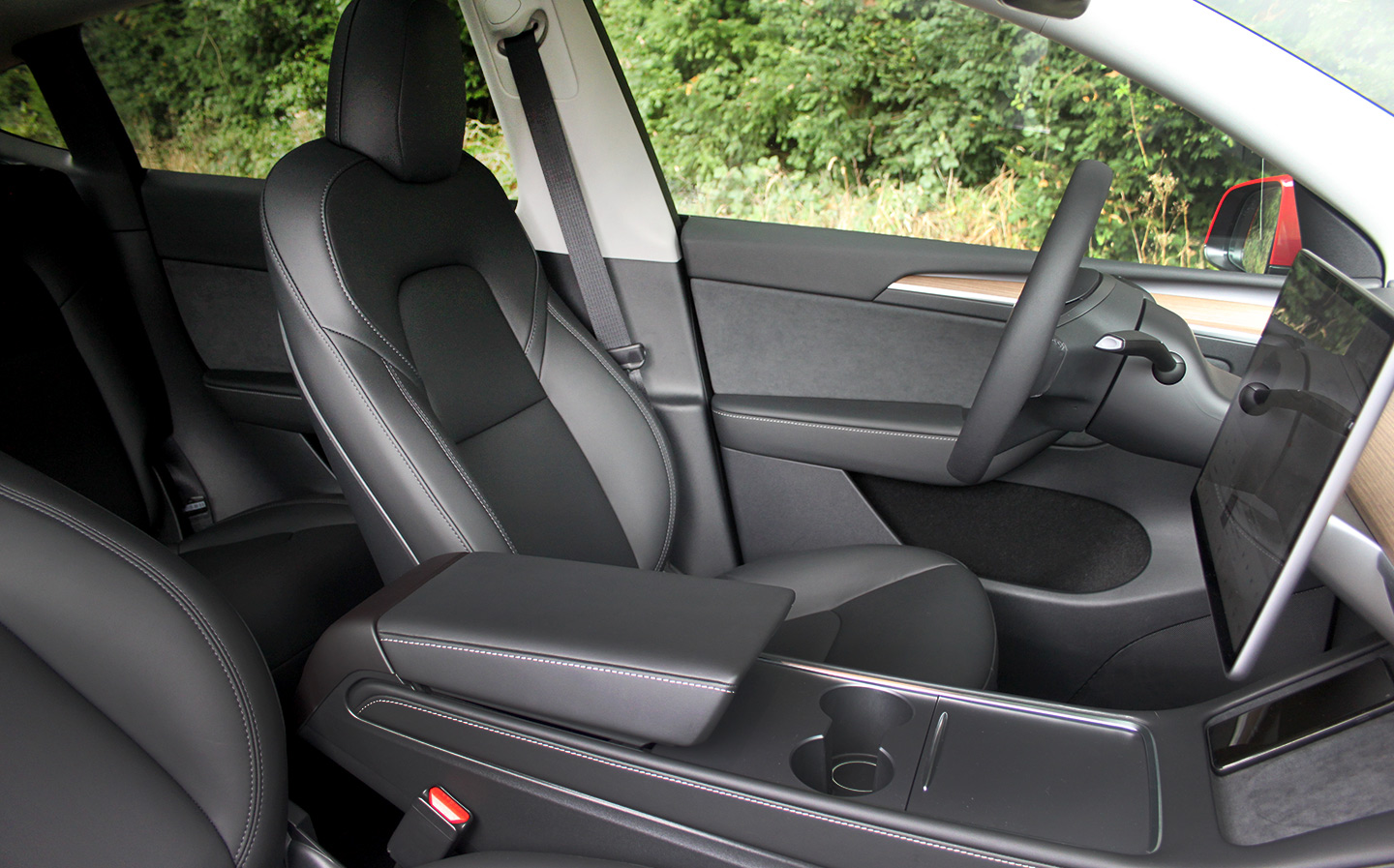
Comfort is impressive. The front seats are well-shaped and heated. The rear seats are heated, too — all three of them. It is a genuine five seater, this car, with plenty of leg room not just because of the distance between the front and rear seats (I can sit behind myself fairly comfortably, and I’m 6ft 5in tall), but also because the floor is completely flat, and the front seats and centre console are mounted up off the deck, creating room for feet. Head room is also exceptional, thanks to the thin glass roof.
Though it’s available with seven seats in the States, the Model Y is currently only a five-seater in Europe and Tesla says it “doesn’t have a timeline” on bringing a seven-seat option to the UK. The company doesn’t say why but an educated guess is that the Shanghai factory, where all right-hand-drive Teslas are built (the new Berlin Gigafactory will only be producing left hand drive models) isn’t tooled ready to do that yet. While “no timeline” doesn’t mean “never”, if you want a seven-seat Tesla right now you can still only go for the larger and pricier Model X.
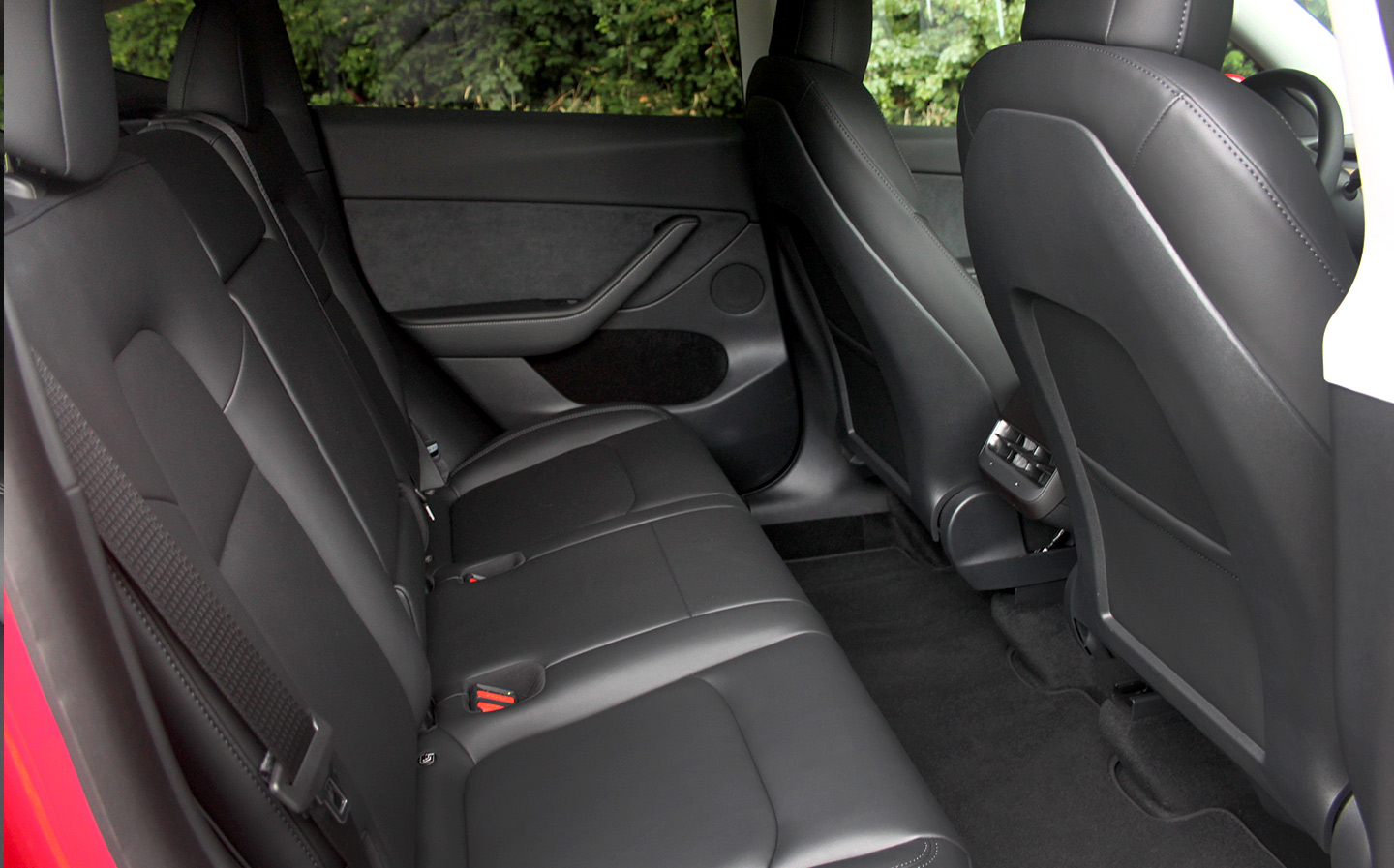
On the plus side, that does mean the Model Y’s boot is cavernous: there’s 854 litres of space in there with the rear seats in place — way above what’s offered by most rivals. Press the two buttons built into the left-hand side to fold the rear seats and you’ve got 2,158 litres, which is a van-like load capacity. What’s more, it’s a hatchback (with electric operation) and features a flat floor, with no painted bumper to catch and scratch, making it incredibly easy to slide objects in and out.
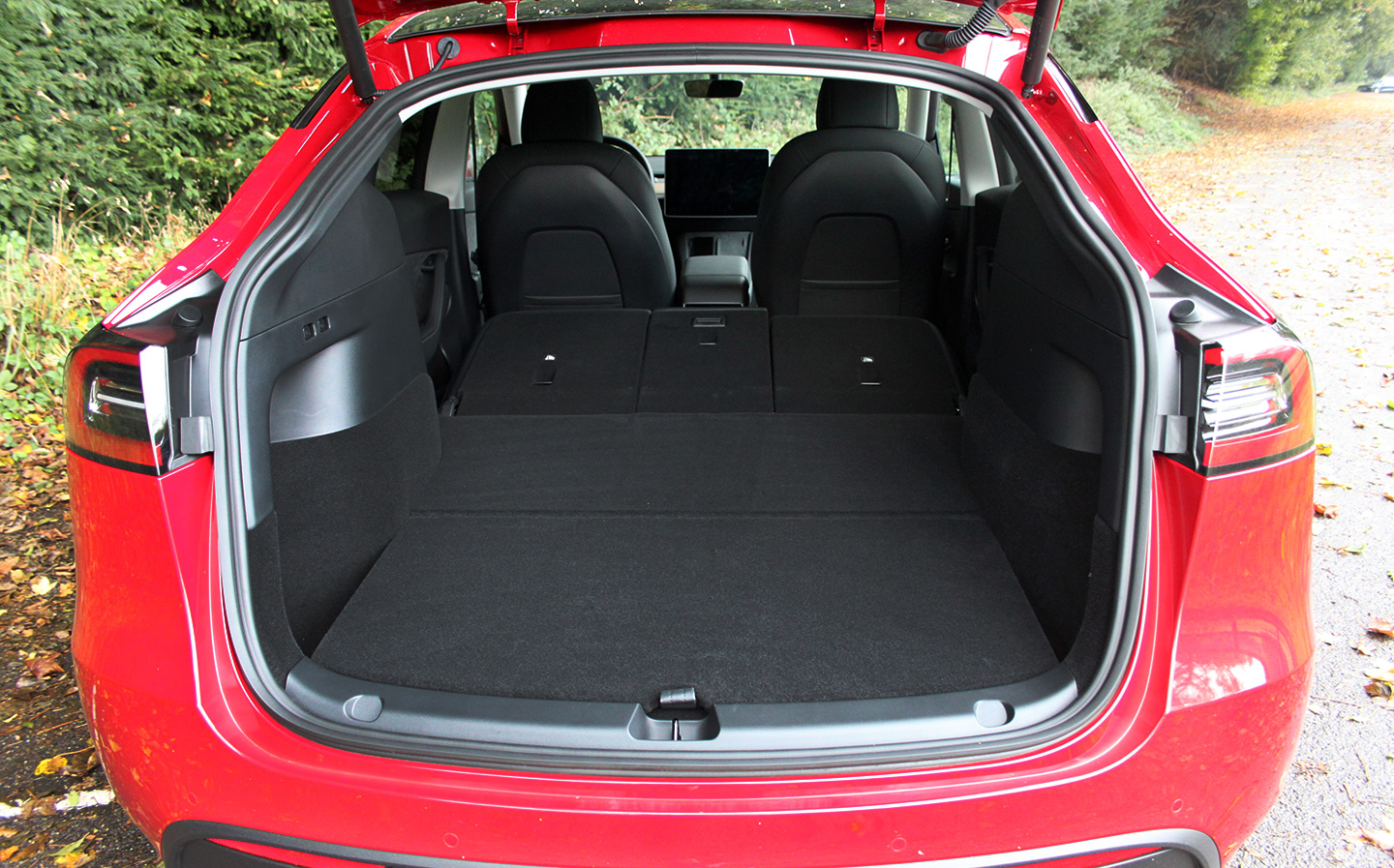
Under the flat floor are two extra compartments for cables and the like, with an additional 117-litre front luggage area (don’t call it a “frunk”, please, for we are British) under the bonnet.
Full marks for comfort, serenity and practicality. Very impressive stuff.
Performance, electric range and charging times
Tesla also gets maximum marks for performance, range and recharging convenience.
Acceleration is rapid: 0-62mph in five seconds dead in our Long Range AWD test car, which makes it super responsive under your right foot, and the Performance model will be able to do it in 3.7sec. Traction and stability are superb from the our-wheel-drive system, and when it comes to overtaking traffic and accelerating away from lights, there’s very little on the road that can beat this car. And you’ll find some drivers of petrol-powered sports cars want to try.
Distance between charges for the Long Range model is 315 miles on a mix of roads (on motorways it’ll be less, in cities it’ll be more), which is plenty and is comparable to the likes of the Ford Mustang Mach-E Extended Range (335 miles) and Ioniq 5 Long Range AWD (285 miles).
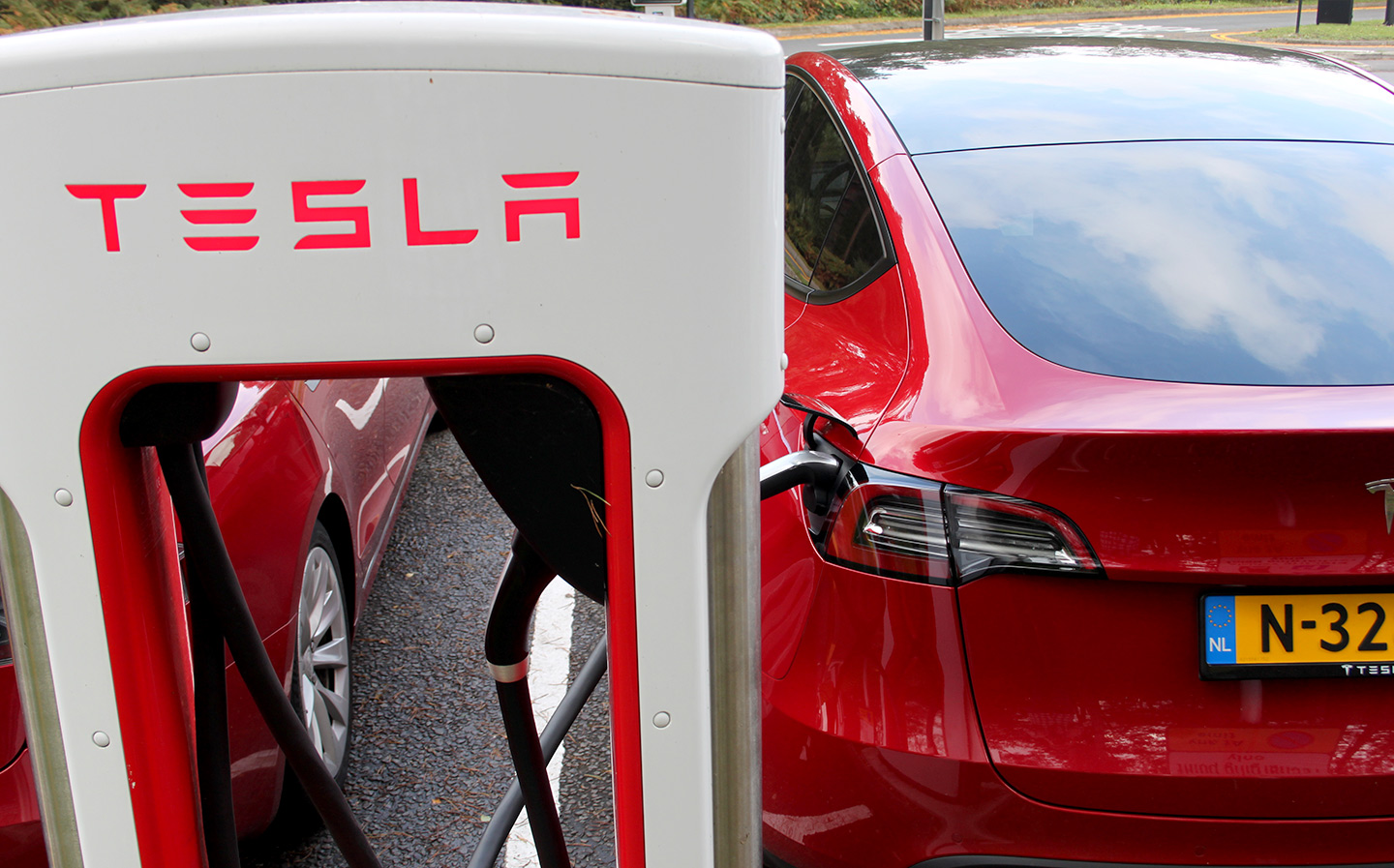
Over 300 miles is way more than most drivers will need for daily use, and if charging at home you’ll wake up to a full battery every morning, but what it enables is long-distance motoring, too. More importantly for road-trippers, though, is that when you do need to stop and charge the Model Y is compatible with the new V3 Superchargers that are capable of adding up to 1,000 miles per hour. There are now more than 6,500 Superchargers across Europe, conveniently located along major arterial roads.
We topped up from an indicated 212 miles of range at the Superchargers at Fleet services on the M3 and saw a maximum charging rate of 250 miles per hour, though we were only taking it to 80% full (after that the charging speed slows, to protect the battery). It took 10 minutes — not even enough time to order a Whopper meal. The charging speed is improved if you set the sat nav to take you to the Supercharger, as the car warms up the battery in preparation.
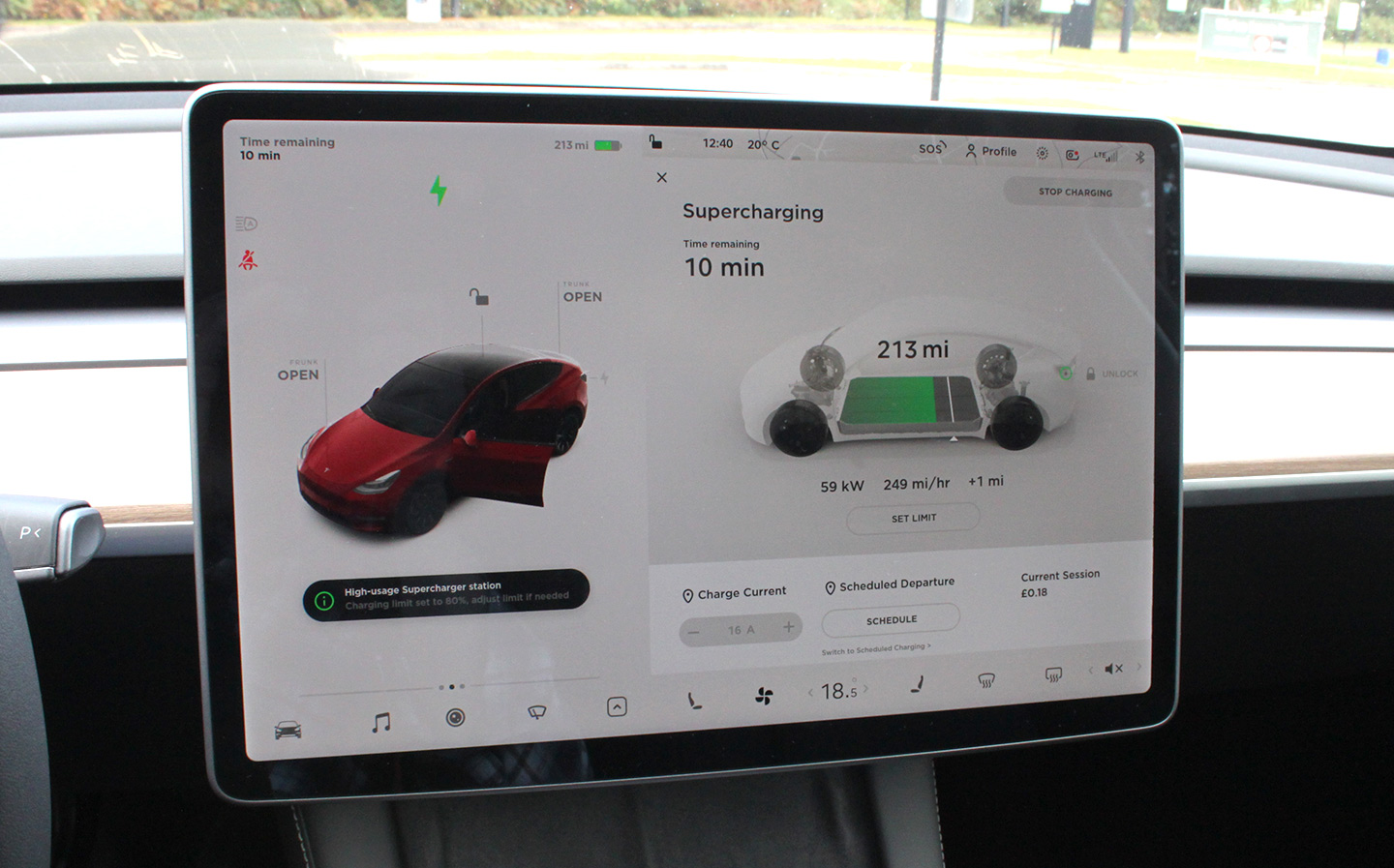
With Superchargers, there’s no tapping of cards or opening smartphone apps: you simply plug in and the charging starts, with billing happening automatically via the account linked to your car.
As with the Model 3, Model Y owners aren’t restricted to Tesla Superchargers: European models come with a CCS connector, which is a standard type for DC rapid charging in the UK, and so owners can plug into pretty much any rapid charger available. It will also accept Type 2 AC recharging, which is slower but more widely available and opens up a lot more opportunities for a top up.
A note about towing: you can have a tow hitch installed by Tesla, which will enable towing up to 1,600kg (braked), but expect range to suffer as a result of lugging around extra weight.
Ride and handling
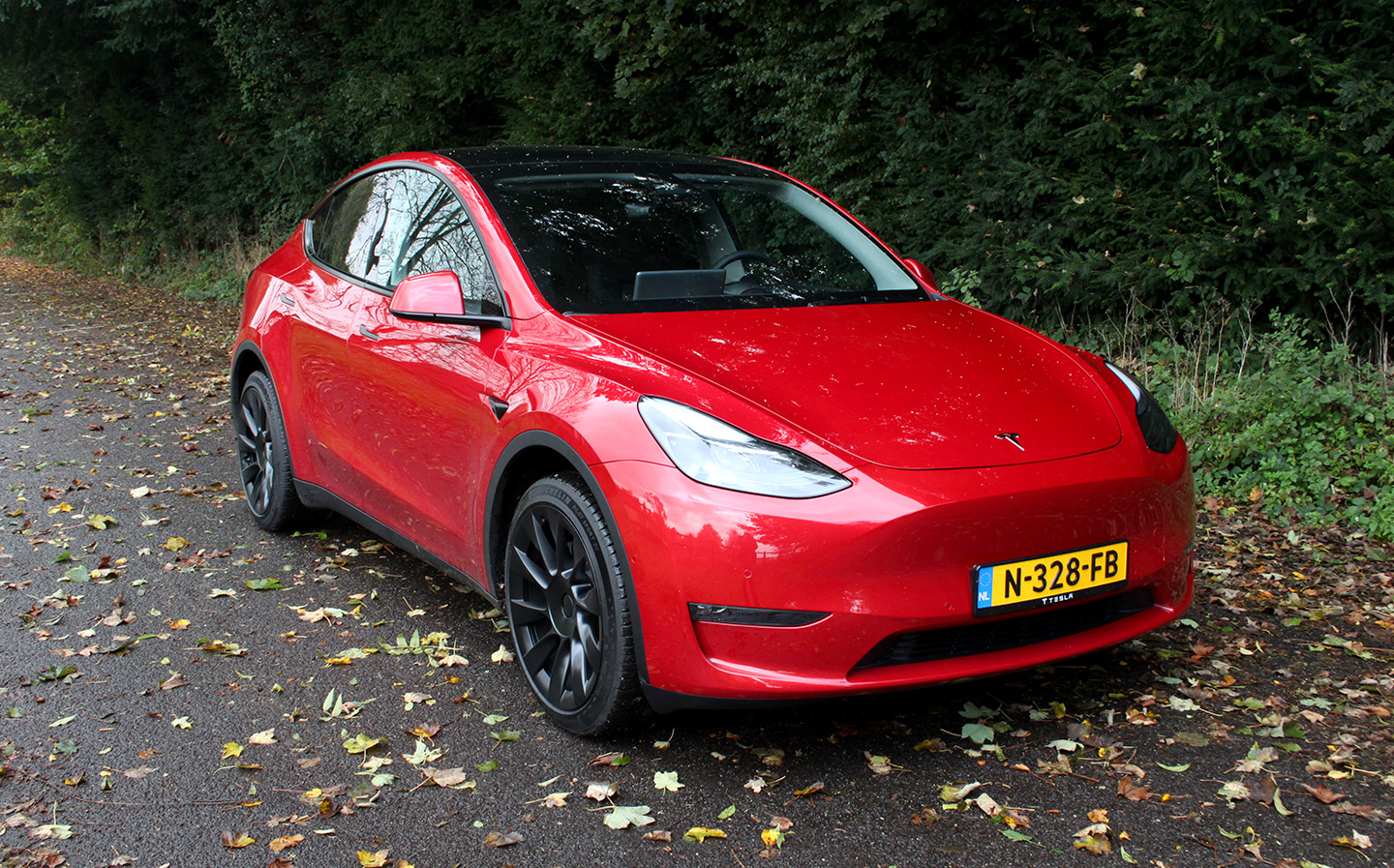
If you were sensing a “but”, here it comes: the suspension on our test car was way too firm in almost all circumstances. It’s the spring rate rather than the damping that’s the issue, and if you’re cruising along a bumpy section of road at about 30mph, not only does it rattle the teeth but you also get loud noises reverberating through the cabin. That’s one of the issues of having such a van-like interior; it’s almost like sitting inside a drum. There were a few rattles coming from the boot area, too.
These are things you might not mind if you are so enamoured with Tesla that you’re blind to any faults, but they are issues that would have been dialled out by more established car makers in the premium sectors, such as Audi, Mercedes and BMW. If one of their engineers were to take a ride in a Tesla Model Y, they would be horrified (or maybe delighted) at the fact that there are so many rattles, bumps and booms through the cabin.
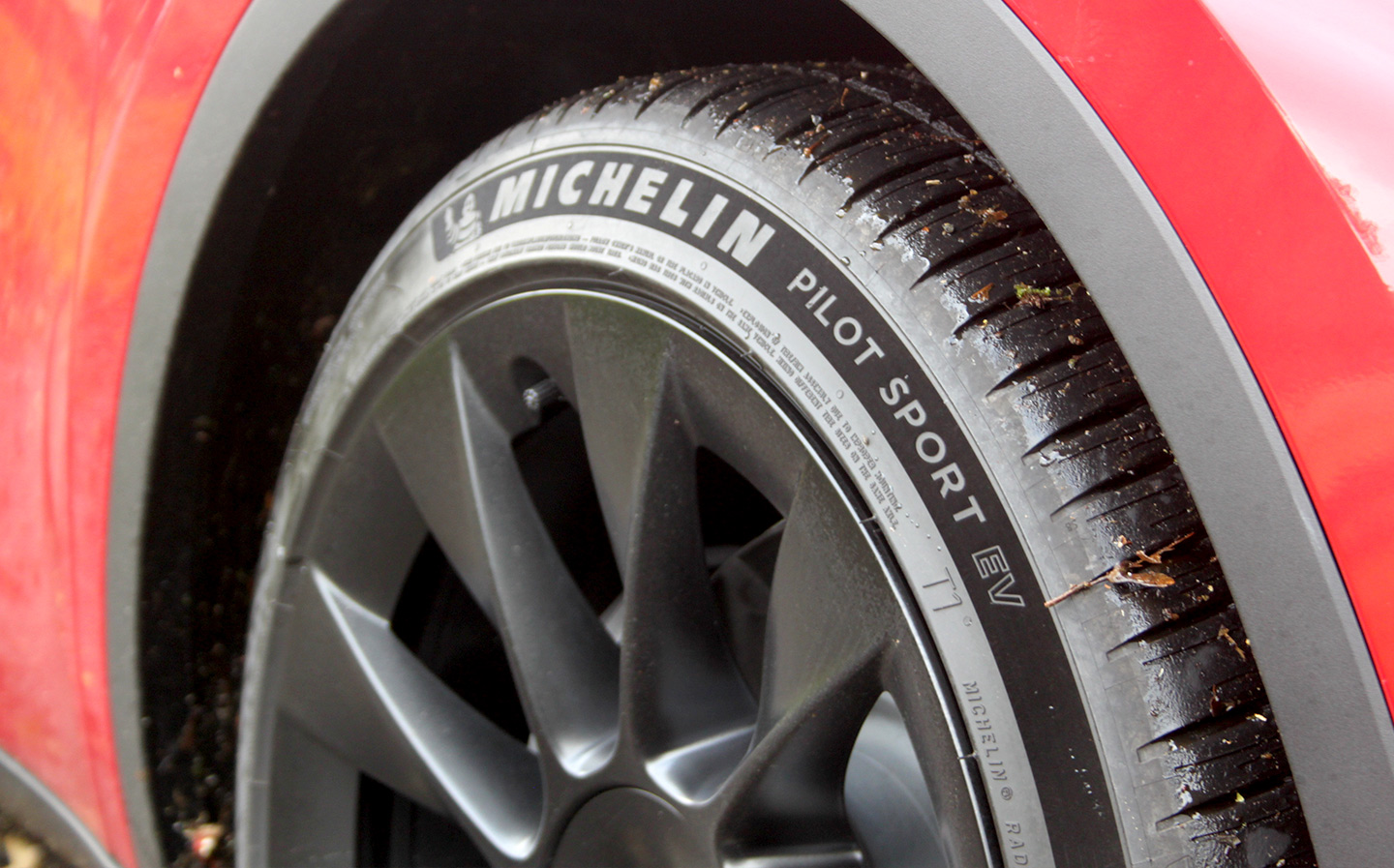
Our advice would definitely be to opt for the smaller 19in wheels, which means a taller tyre sidewall and therefore better cushioning, at the expense of cornering responsiveness. Increasing the load in the car (filling it with people and luggage) may also improve the ride, as it’s possible the spring rate is set up to handle the car’s maximum load. But carrying around lead weights isn’t terribly practical or economical.
At higher speeds, while there is a fair amount of wind noise at the front (unusual for a Tesla because they are so streamlined), the ride improves greatly and the stiff suspension along with the low centre of gravity from the underfloor battery pack results in keen handling. There’s very little body roll and the car is ultra responsive at the front end. The steering rack is really quick, too, so you have to be very gentle with the wheel but again, this suits the sporty character of the car.
How much is a Tesla Model Y in the UK?
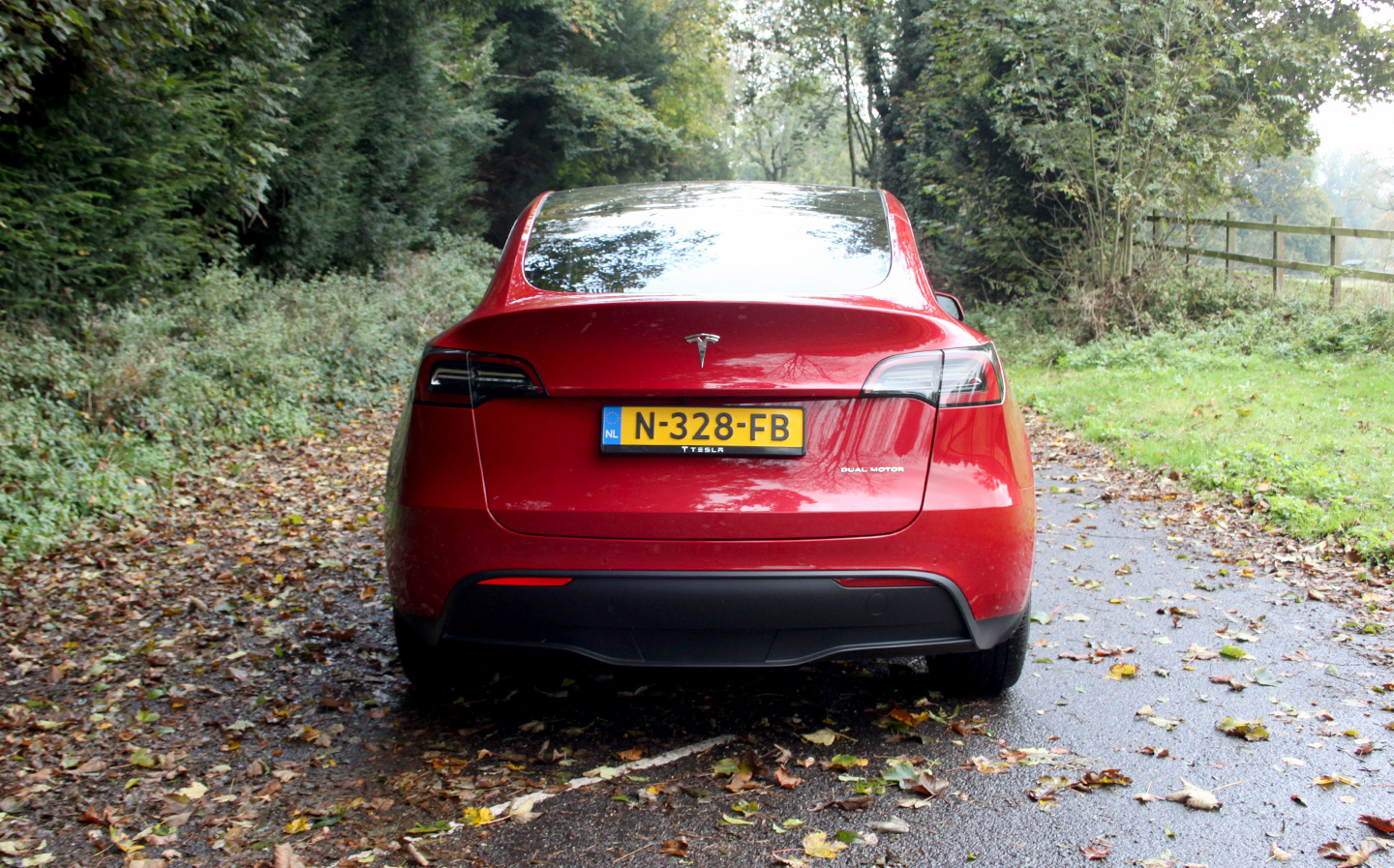
Prices for the right-hand drive Model Y are higher than expected when the car first went on sale in the US: British customers will need to fork out upwards of £54,990 for the Long Range AWD version, whereas in America it costs $50,690 (£36,792) excluding local incentives. And (breathe in) the Model Y Performance costs from £64,990.
You do get a Basic Vehicle Limited Warranty thrown in, which covers the vehicle for four years or around 50,000 miles, whichever comes first, while the battery and drive unit have a warranty of eight years or about 120,000 miles. Tesla expects the battery capacity not to drop below 70% over the warranty period, through normal use.
And standard equipment includes basic Autopilot; power adjustable heated front seats; 14 speaker audio system; tinted glass roof; power folding, heated side mirrors; Hepa air filtration system; and two smartphone docks with wireless charging.
When does Model Y go on sale, and when will deliveries start?
Tesla is already accepting orders for the Model Y in the UK, with a £100 non-refundable reservation fee.
The first cars to be delivered will be the Model Y Long Range AWD, estimated in early 2022, with the Performance models expected to arrive in Britain from summer 2022.
Verdict: 2022 Tesla Model Y review
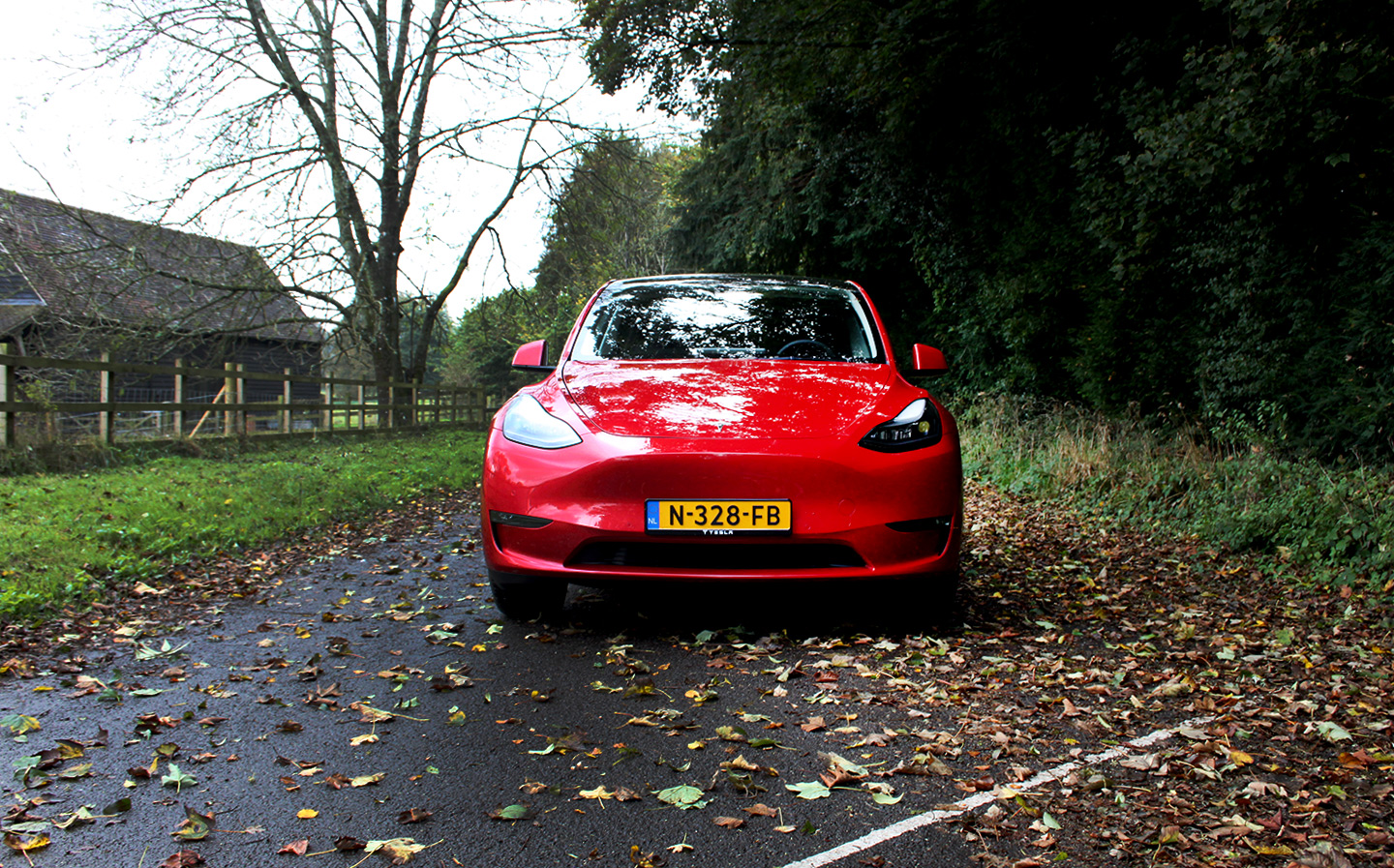
Tesla has a fanboy following for a reason: it makes great cars. They’re not faultless, and there have been doubts in the past over build quality and repair times, but they’re often segment-leading in terms of technology, practicality and performance.
The Tesla Model Y is no exception — it takes all the best qualities of the Model 3 and adds to them with extra utility and convenience. For a compact crossover, the interior is absolutely enormous, and the acceleration, braking and handling are exhilarating. Rapid recharging via the Tesla Supercharger network and top safety features are also noteworthy.
The UK spec Model Y is pricier than expected, and on British roads it’s let down by an overly-stiff ride and a boomy, rattly cabin — particularly at low speeds — but if you opt for the smallest 19in wheels, that should be mitigated to some degree.
As a package, owners are likely to be delighted.
- If you enjoyed this review of the UK Tesla Model Y, take a look our review of the 2019 Tesla Model 3
- You might also like to take a look at five electric car alternatives to the Tesla Model 3
- And check out this story about the Tesla Autopilot system being investigated by a US safety organisation


